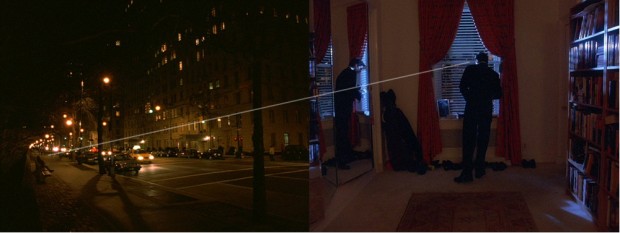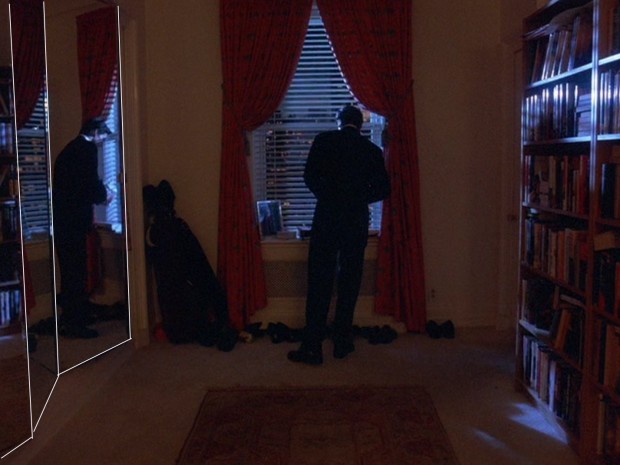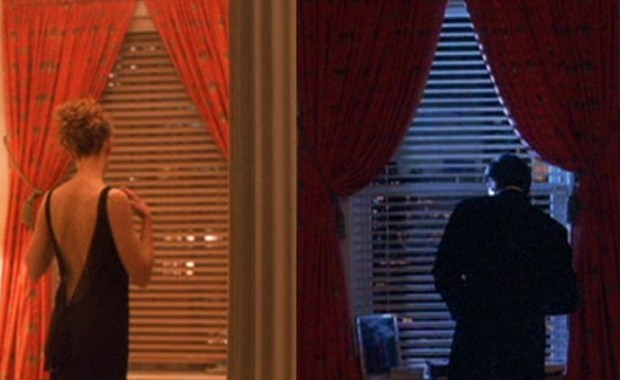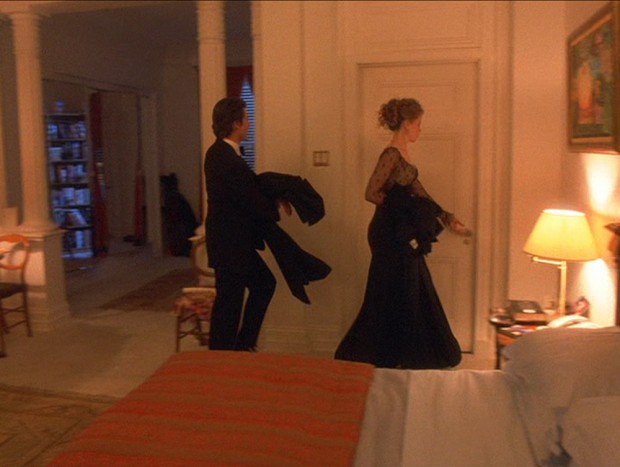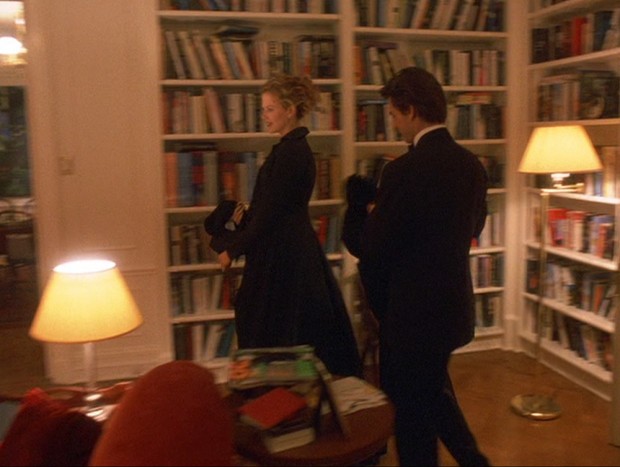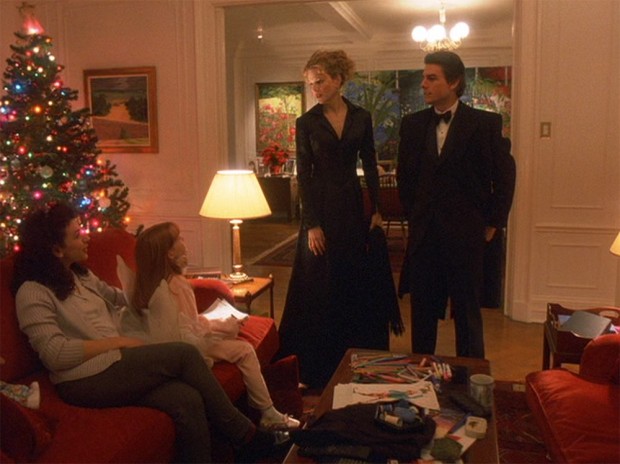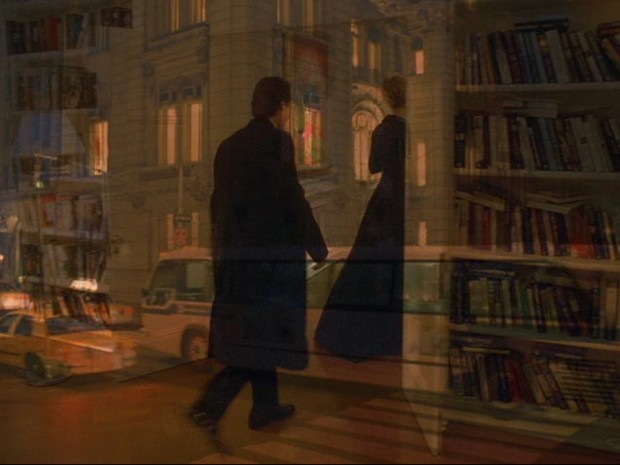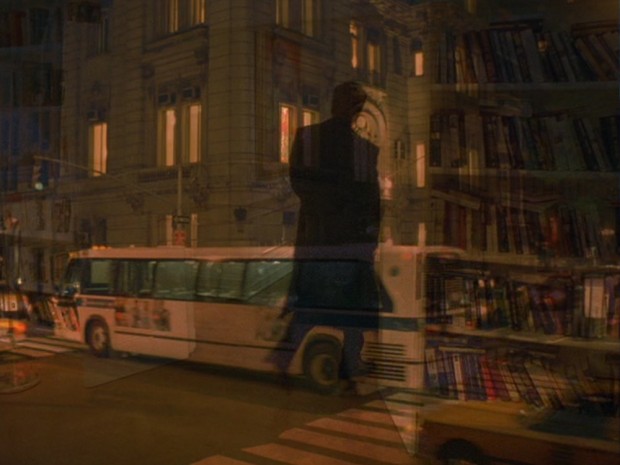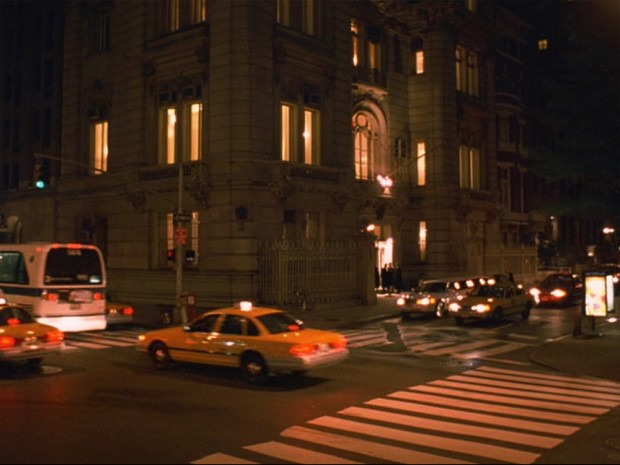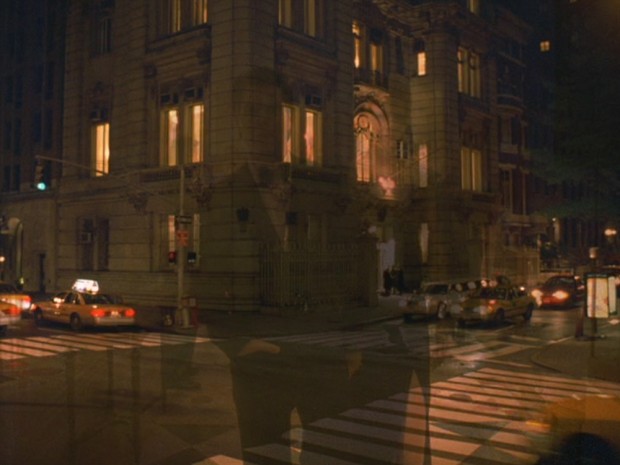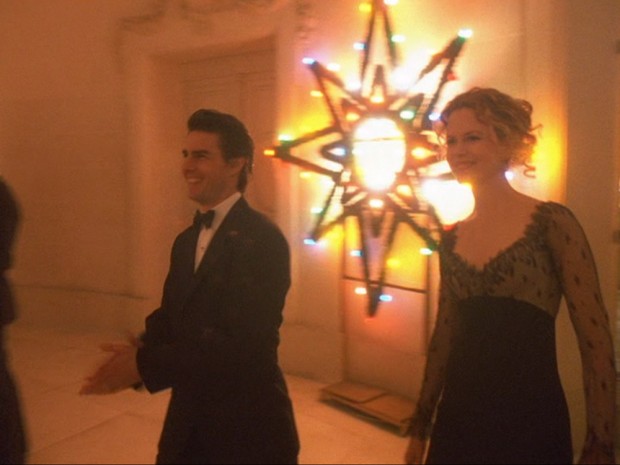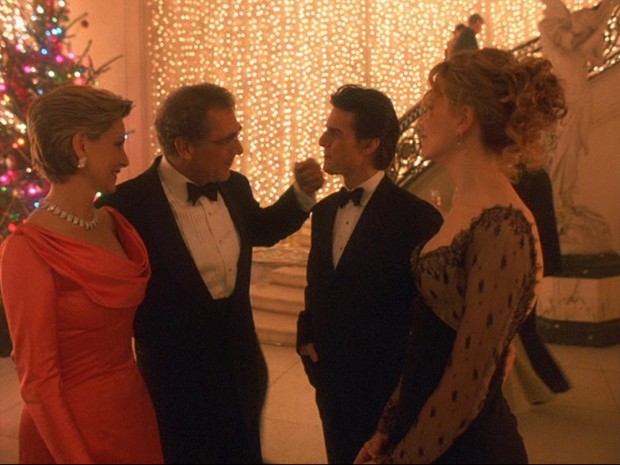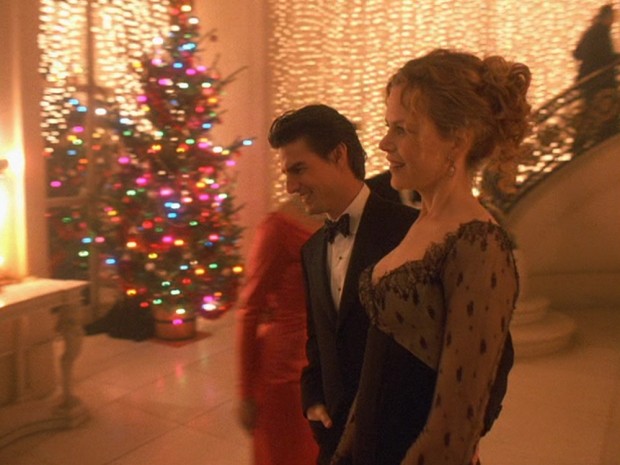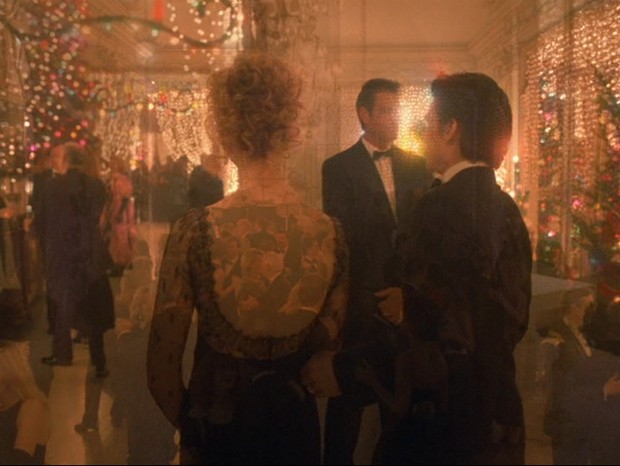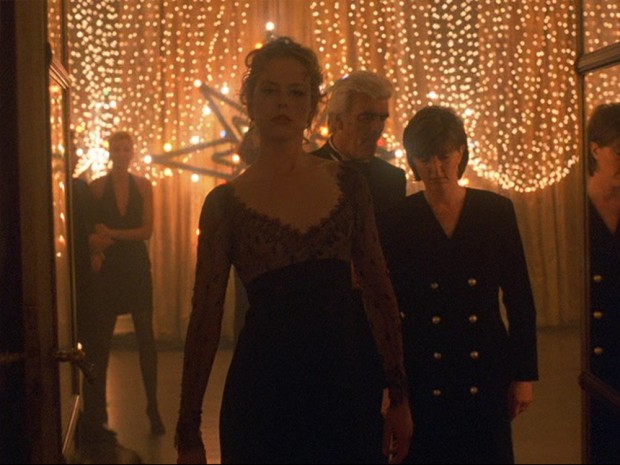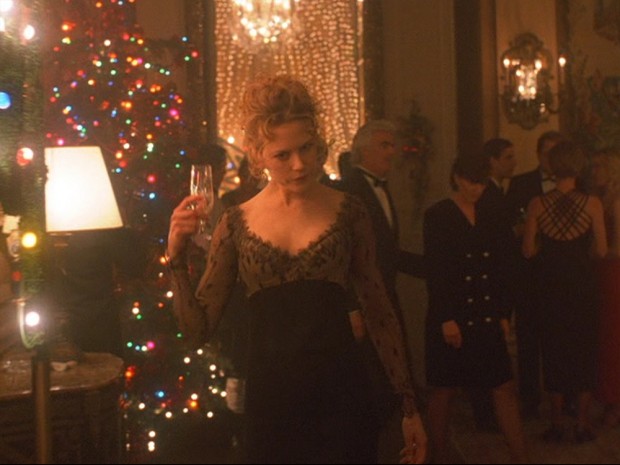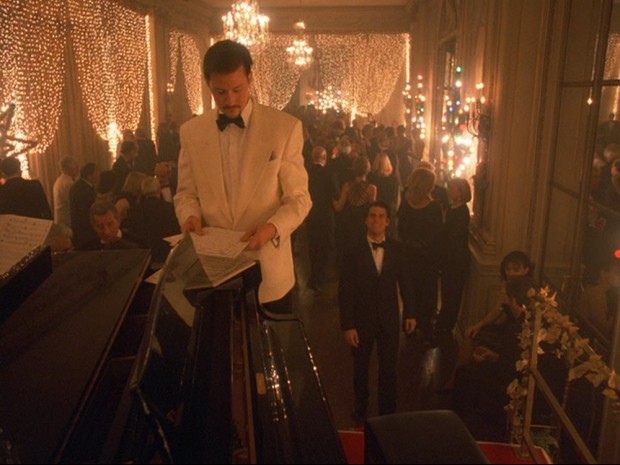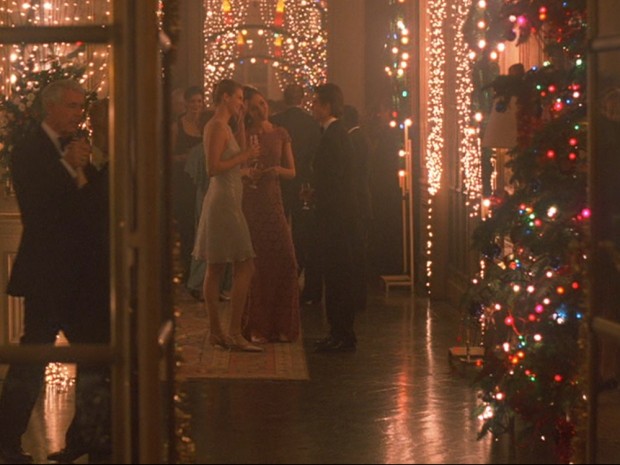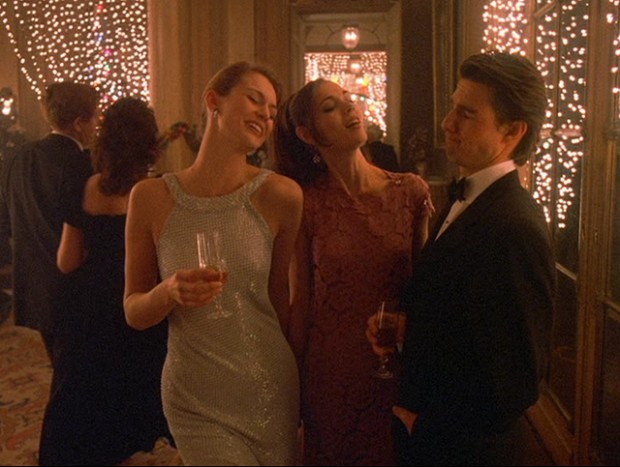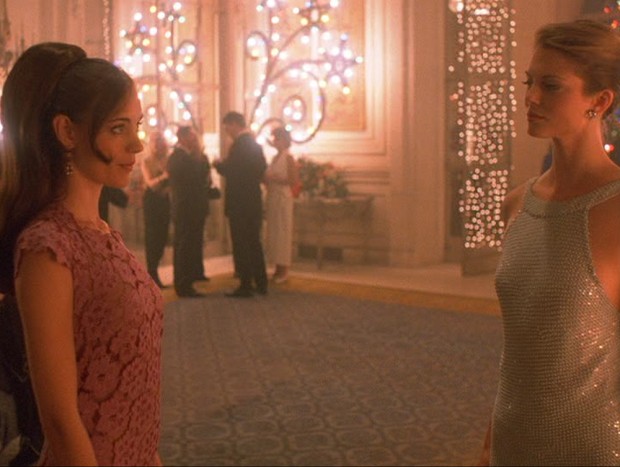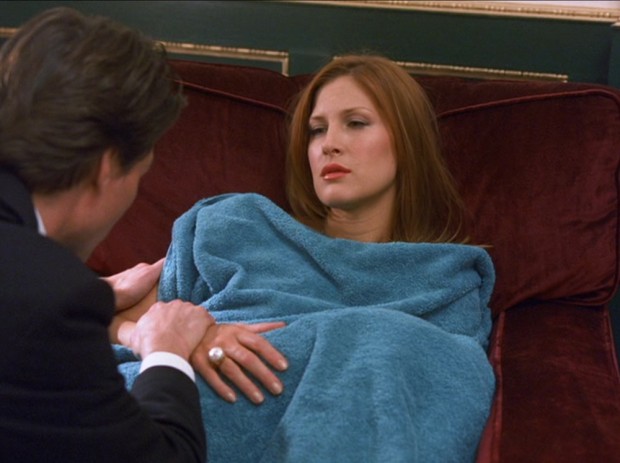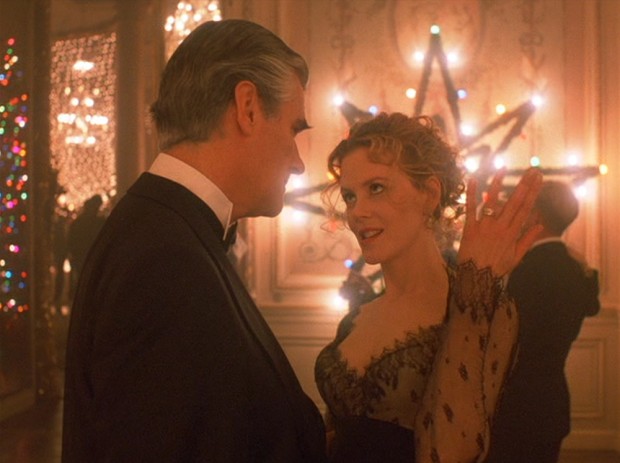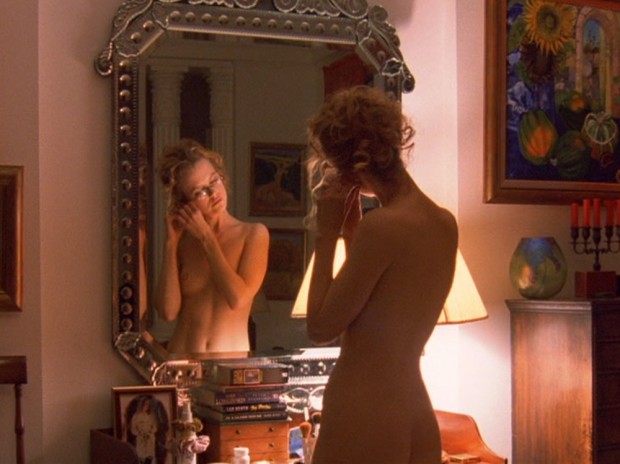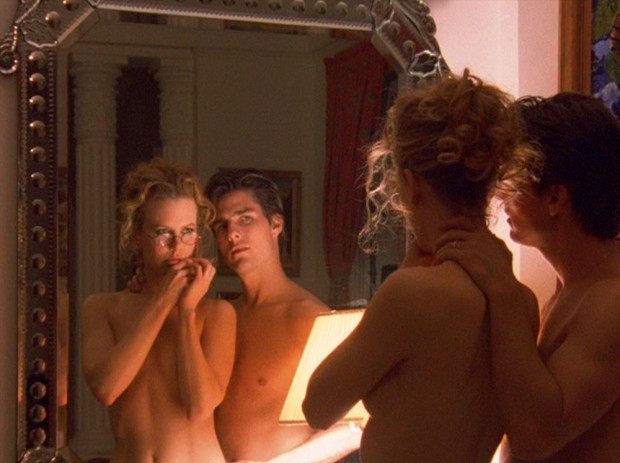STANLEY KUBRICK'S EYES WIDE SHUT

PART ONE
TOC and Supplemental Posts | Part 1 | Part 2 | Part 3 | Part 4 | Part 5 | Part 6 | Part 7 | Part 8 | Part 9 | Films Home
LINKS TO SECTIONS OF THE ANALYSIS ON THIS PAGE:
The First Waltz Two, Shots 1 through 12
The first echelon. Differences between the first dressing room scene and the second. Foreshadowing the black cloaks. The mirrors. The different views out the dressing room window. The dance before the dance. The problem of not being seen. The painting of the grounds of Mentmore (Somerton) in the living room.
The Ziegler's Party, Shots 13 through 32
View of a hidden 237. The story of Helen of Troy. Cupid and Psyche. Linking the Ziegler mansion, Sharky's, and Rainbow costume rental. The festival of lights and the Christmas season. One woman replaces another. Alice's failed art gallery and Sandor's offer of help. Temperance and Gemini. The invitation to the end of the rainbow, Sagittarius, QShTh, and Fidelio. A possible for CRM-114. An initiation.
The Overdose, Shots 33 through 55
Painting of a pregnancy. The theme of the eye in Kubrick's work. The switch from the red phone and twisted lamp to the drug paraphernalia and another lamp. A lucky girl. An understanding.
The Mirror, Shots 56 through 57
The switch of paintings. Compared to the book.
THE FIRST WALTZ TWO
THE FIRST ECHELON AND DIVERSIONS - DIFFERENCES BETWEEN THE FIRST DRESSING ROOM SCENE AND THE SECOND - FORESHADOWING THE BLACK CLOAKS - THE MIRRORS - THE DIFFERENT VIEWS OUT THE DRESSING ROOM WINDOW - THE DANCE BEFORE THE DANCE - THE PAINTING OF THE GROUNDS OF MENTMORE (SOMERTON) IN THE LIVING ROOM
SKIP ALL THIS AND TAKE ME TO THE TL;DR WRAP-UP AT THE END OF THE PAGE.
Credits. Bold white letters on black that quietly fade in, hold, fade out, a sensuous and lyrical jazz waltz with sax riding over. Long misidentified as Concertgeboux Amsterdam's rendition of Dmitri Shostakovich's "Jazz Suite 2 - Waltz 2", the dance with which Kubrick has chosen to open the film is instead Waltz 2 (in C minor and E-flat major) from Shostakovich's Suite for Variety Orchestra. It is based on one Shostakovich scored for the 1955 film The First Echelon (Perviy Echelon), by Mikhail Kalatozov, concerning the Virgin Lands program in which hundreds of thousands of Russians were resettled as farmers in the central Asian area of Kazakhstan.
The title of Kalatozov's film hints at a type of deep battle Russian theory of warfare in which the defense would be confused by diversionary, multiple parallel and successive operations, the tactical aim being to leave the object of these campaigns unable to conclude and focus on what is the main objective. The way Kubrick tailors his choice of music for a film, the title and history often informative, I would suggest that one of his reasons for using this piece was due this deep battle theory, Bill under siege of various confrontations and dilemmas which he at first views as unrelated and coincidental, then paranoia setting in over a perceived unity of purpose behind at least some of the events, followed by even more bewilderment as the ground under him shifts yet again, his fears and beliefs simultaneously confirmed and denied in such a way that he is completely undone when he faces the "mask" in its ultimate revelation, the Bill he was only a couple of days prior suddenly and forever gone, along with his former world paradigm.
However, not only is Bill under siege with diversionary, multiple parallel and successive operations, so is the audience member watching the film.
[A supplemental post on the waltz is here.]
1 Credits begin - Warner Brothers Presents (00:20)
2 Tom Cruise (00:24)
3 Nicole Kidman (00:27)
4 A film by Stanley Kubrick (00:31)
5 LS Alice in dressing room (00:36)
A setting of the stage for alternate realities in a dressing room where daily takes place the rite of costuming and masking. Against the opposite wall are two tennis rackets in the left corner beside a floor lamp. Alice's shoes line the wall under a window draped with long red curtains held back with gold pulls, the slats of the Venetian blinds underneath open on neighboring skyscrapers. A newspaper or tabloid appears to rest on the floor before the shoes because--because? I would imagine the newspaper is there because of the "Lucky to be Alive" tabloid that Bill will later read in the cafe. Not that this is the paper but that it connects with it, for in the article Bill will read at the cafe are the lines, "After being hired for a series of magazine ads for London fashions designer Leon Vitali, rumors began circulating of an affair between the two. Soon after her hiring, Vitali empire insiders were reporting that their boss adored Curran -- not for how she wore his stunning clothes in public, but for how she wowed him by taking them off in private, seductive solo performances." We are, for the moment, as Vitali adoring Curran, Alice removing her clothing in a seductive solo performance.
To the left is a closet with several mirrored doors, one of them open and the interior of that door reflected in the neighboring one.
In the closet, barely observable, is what appears to be a long white dress, possibly Alice's wedding gown with a black suit coat that may be Bill's wedding tux. This makes sense as the essence of the story is about marriage.
Classical columns separate us from the tableau as, back to the camera, Alice Harford (Nicole Kidman) nonchalantly slips off a black dress (a surprise to the viewer that she is nude underneath) and kicks it into the corner. Exterior the room, on the left is the very edge of a circular table.
The segmented manner in which the scene is reflected multiple times in the mirrored doors echoes the blurred, doubled effect of the two tennis rackets against the wall--one with a brown handle, one with a black--as if two distinct but nearly identical copies are not completely in sync. The pair of shoes next the rackets enhances the blurred effect, as does the folding arm of the floor lamp which interrupts the lamp's straight line, offsetting the shade.
The reflection of the interior of the glass door and its handle in the neighboring mirror makes it difficult to tell where the mirrored doors of the closet begin and end, and augments the studied but understated disequilibrium of the scene, appearances at odds with physical realities.
To add to the confusion, Alice's dress is itself odd in the way it has dual, matching long tails, toward the height of which are ruffles that hang between the split.
If we look at Alice's black dress more closely we see that though it appears to be opaque its cloth is instead fairly sheer, which means the dress would be too revealing for most social situations. It has been suggested to me that the dress appears to be torn. To my eye, however, the edges appear to be finished and this is instead a split swallowtail garment of peculiar and thus provocative design. Up close and personal the dress may be without mystery, but the appearance it presents the camera's eye is a puzzle. We are unable to get a good read on it no matter how hard we may try, no matter how closely we look.
A swallowtail cut may refer to the swallowtail butterfly. As I've mentioned above, Nicole's undressing reminds of the newspaper article in which it's mentioned how Amanda Curran was appreciated by Vitali for her removal of clothing in a seductive solo performance. Bill reads about this at Sharky's where an image of butterflies is on the wall.
At first glance, the complexity of the awkward split swallowtail and the ruffles may trick the viewer into anticipating Alice wears a half-slip and dress rather than a single garment. But then Alice slips off her dress in an easy kind of desultory strip tease and the world sees Nicole Kidman's posterior and no one notices anything odd about the film for the next five minutes.
And that is what we could call a diversionary deep battle operation, with which this film is rife.
The scene is brief and its presentation of antagonizing appearances are so understated as to be largely unnoticed, but these muted conflicts set the stage for the psychological and philosophical sensibility of the film.
6 Title card - Eyes Wide Shut (00:45)
7 LS NY Street and Residential Highrise (00:50)
An establishing shot of the exterior of the Harford apartment building. When I first did my analysis, my supposition was that it is the San Remo building at 145/146 Central Park West, billed as one of the more prestigious addresses in New York. That ID has since been confirmed on movie location sites.
We are looking at the corner of the building adjacent to 75th Street.
I have made a separate blog post on it at this link.
Though the majority of viewers won't know this building is the San Remo, Kubrick immediately establishes that the Harfords are fabulously well to do by the standards of anyone who isn't insanely well to do.
A coincidental aside. 237 appears several times in the film, a number used not only in The Shining but which makes a discreet appearance in 2001. The facade used for Victor's mansion neighbors, in real life, 237 Madison Avenue, a hotel directly behind it. On set, 237 is the address of the Verona Restaurant and 236 is the address directly across the hospital, which implies the hospital is 237. How 237 relates to the San Remo is that there is an old hotel in San Francisco called the San Remo, which has been there since 1906, its address being 2237 Mason Street. Is it pure coincidence that Kubrick has Bill and Alice living in a building that has a (sort of) 237 twin in San Fran? It very well may be. (And of course it's not exactly 237.) But in Bill's later encounter with the fraternity ruffians they tell him he should go back to San Fran where he belongs, which gives me cause to wonder if Kubrick knew of this other San Remo. If this is the case, it is not a capricious doppleganger, for doubling is a persistent theme in all Kubrick's films.
The music takes on a circusy tinge with the night view of Central Park West, cabs passing the upper class apartment building in which Alice and Bill Harford live, on the opposite walk of which rests a figure on a bench. In the foreground, he stands out as a conspicuous oddity, however natural the situation, his conspicuousness perhaps caused by his stillness, and maybe even the feeling the bulk of his upper body is too dark, as if its personhood has been intentionally obscured, as if we are aware that in other films, non-Kubrick films, this figure would be less stolid, less fixed, less a blank, and not at all mysterious. Kubrick returns to this scene in shot 437 when Bill arrives home from his second visit to Somerton and finds Alice helping their daughter, Helena, with her math homework.
Though we see only cabs and cars, we hear the clipped wail of a nearby siren.
8 LS Bill in dressing room (00:55)
The street scene is answered by Bill standing before the window, seeming to be looking down on the street to the left, so we may be reminded of the figure on the bench.
The sound of the siren briefly lingers then blends into the music and disappears.
Kubrick opening this shot with Bill Harford (Tom Cruise) looking to screen-left makes it responsive to the shot prior and seems to establish the man on the bench as being a meaningful presence, foreshadowing also the later revelation of Bill being followed, though this tailing doesn't occur until after Bill's first trip to Somerton.
Some believe the figure on the bench is intended to represent Kubrick. Perhaps it does. Kubrick inserted Burgess into A Clockwork Orange, as the author of Alex's existence, a sort of father-god, and inserted the "author" into The Shining. I have discussed this some in my analyses of those films. It may be that Kubrick inserted himself here. But the fact is that though these initial scenes of Alice and Bill dressing and much of the ensuing party aren't in the book, there is such a scene of a man on a bench in the novel. Fridolin (Bill) sees him when he goes out after his argument with his wife, and has a dialogue with himself on whether he should help him, talking himself out of it, after which he carries on a relentless internal debate all night, wrestling with whether he is middle class complacent and cowardly, for his decisions for inaction are made out of fear of possible consequences. What if the man on the bench should continue to want help? He feared becoming involved and obligated.
We are viewing the dressing room again, further in it than before, beyond the columns that had somewhat theatrically separated us from Alice, our perspective such that now we're able to see bookcases and a far door to the right that had not been previously in sight and will never be used. The dressing room now unlit, the floor lamp and tennis rackets that had been in the far left corner are replaced by several long slender objects sheathed in black casings. The black casings are tied in such a way that the shape suggests a head, neck and body, and if we know there is the party later in which attendees wear black cloaks with hoods we are perhaps reminded of the cloaks.
This is Bill's version of the dressing room, which will become clear in a moment, and if we only now see the books in these cases they are likely Bill's, perhaps medical texts. But just as the (possible) newspaper on the floor of Alice's version of the dressing room perhaps refers to the "Lucky to be Alive" tabloid and its mention of Curran's seductive strip tease, these books may connect with Victor's billiard room/library in which Bill will receive the news that Victor had him followed, or the library at the Somerton "orgy" where Bill is invited to retire to a more private place by a woman seemingly directed to him by a masked Victor.
Whereas Alice's shoes had lined the floor under the window before, now many pairs of Bill's black shoes do, and only when Bill moves will we see a lighter shade of shoes belonging to Alice. There is also a seeming, single gold shoe (I'm not certain of this) beside the black sheathed objects, while behind them lies what appears to be a red piece of clothing neglected on the floor in the corner. Allusions to both these articles may occur later in the film, for a gold shoe (without its second) is observed on a pizza box in Domino's apartment, and at the Rainbow shop will be a Japanese man in a red thong who is revealed as hiding behind clothing in a dressing/sitting room.
A framed picture or small mirror rests upon the sill of the window and some other articles that hadn't been there before.
A rug now overlays the carpet and hadn't been present in the previous scene. This same rug will appear later in the film in the private dressing/sitting room at the Rainbow shop.
Bill is reflected in the mirrors of the closet on the left as he appears to gaze out the window into the street below, but whether he was actually observing the street becomes unclear as he is also revealed as looking about on the windowsill for something. That Bill is reflected in the mirrored doors alerts us that Alice was not.
The construction of the mirrored doors appears to be entirely different in the two scenes--the one in which Alice is undressing and the one in which Bill finishes dressing--but it's a matter of illusion. In the first scene with Alice, the doors obviously begin several inches from the ground above an encasement and are hinged so they open out. Here, the doors appear to be longer and give the appearance of being set directly on the ground or about an inch above. If one compares these closet doors with those in the dressing scene with Alice. these appear to be below the low molding and not even on tracks. They look more like accordion doors in the scene with Bill. But, again, as I note above, this may be illusory.
Though we only see three closet doors in the shot with Bill, these are the same as in the scene with Alice. The fourth and farthest door from us, however, is hidden in the dressing room scene with Bill.
Bill has placed down on the window sill something he was holding (it appears to be black cloth, we will never know what it was). He turns and we observe he's dressed for a party in his tux and bow tie. As Bill turns and walks toward us, due the manner in which the doors are situated, he disappears from them briefly, not observed in the second door, which is notable because Kubrick uses a similar effect with dancers later at Ziegler's party, causing one couple to seemingly briefly disappear when instead we were only viewing their reflection.
Kubrick has a habit of making objects disappear and surreptitiously changing one object for another. We will later have a revisiting of these two dressing rooms at the costume shop.
The audience is going to assume, is perhaps intended to assume, that the first scene showed Alice dressing for the same party for which Bill is now attired, and was dissatisfied with that dress as she goes to the party in another. Or, if one hasn't paid careful attention to what Alice is wearing, one may casually, later reflect back on the first scene and believe Alice was undressing after the party. Once one realizes how different the dressing room is in both scenes, one might believe Kubrick intended the first scene to be on a different day.
One may consider that the earlier scene of Alice could possibly be the end of the night the prior year they went to the Ziegler's party, for at the party Alice asks why they are invited every year, but the sheerness of the dress Alice removes is such that it's utterly inappropriate for such a party.
It would be, however, very appropriate for the party at Somerton, and is tailored to stick in our mind for later consideration and reflection on this.
The fact is these are two different dressing rooms when one examines them, and by making them different, Kubrick makes us struggle to rectify the two. First he causes us to guess "why" Alice removes her dress at the film's beginning, and then when we see how different the dressing rooms are we must struggle with time and, finally, place. To look for rationalizations that can fit into a literal, everyday narrative in such an expressionist and often irrational (in terms of the physical world) manner of story-telling as Kubrick employs is really not the way to pursue Kubrick's work. There is no explaining away the differences between Alice's dressing room scene and Bill's, the change in props, by simply suggesting the first scene has occurred a year prior. For even if such a scenario seems a reasonable answer, Kubrick's films remain filled with intentional and impossible curiosities that defy realism.
The view out the window isn't even the same.
That's right. The view out the two dressing room windows isn't even the same. With Alice, the view is all skyscrapers and their lights from top to bottom. With Bill, half of the window is filled with sky. There is no explaining this away as sloppy continuity. It's an intentional and dramatic mismatch between the two scenes. When we are dealing with such mismatches, as if a juxtaposition of several different realities, or the revelation of a reality in flux, and the film is not intended to be a fantasy, then we have to adopt an altogether different way of examining the movie than we would if it was undiluted realism or straight fantasy.
If the observer hasn't noticed anything is awry, there is perhaps a sense of subconscious unease if the eye has caught the differences but the brain shies from recognizing them due the appearance of realism.
Kubrick utilizes doublings and makes small but sometimes bold alterations in sets that disrupt continuity. In all his films he employs deja vu and circularity so that scenes are revisted and play out in different ways. One thinks of deja vu when one thinks of The Shining, but Lolita opens and closes with Humbert at Quilty's mansion, and yet if we closely examine Humbert's entering the mansion in those two scenes we find they are different, they aren't the same take. We've deja vu rather than an exact replay. "Double" derives from the same root, shanah, in Hebrew, as "to fold", "a second time" and "to alter". In my writing on The Shining I propose that Kubrick utilizes word play to bring in concepts to do with shanah (for instance, a connection between the opening music of "Dies Irae" and Rosh Hashannah). I believe that is what we have happening here. Two scenes, both supposedly in the same room, both seeming to refer to the same party, and yet there is such significant alteration between the two that they don't match up. There is no possible way of reconciling them.
Recollect also how we have, especially in the view of the room with Alice, a sense of doublings within it, almost a kind of double vision. Then there is perhaps a newspaper or tabloid resting on the floor before all the pairs of shoes. I stated that I think it connects with the "Lucky to be Alive" scene at the coffee house. This has partly to do with the doublings--and even in the article that Bill reads at the cafe there are three doublings of content, three lengthy sentence fragments are repeated twice in the article.
But all this is information rather discreetly offered the audience by Kubrick. Instead, first and foremost, we must focus on the story of Bill and Alice, what the viewer comes to the movie to see. One two three, one two three plays the waltz as Bill and Alice are preparing to leave for a party.
Bill's hands searching his shirt and jacket, he exits the dressing room into the bedroom, stopping at a small round table on the left. The table and its chairs rest under a pastoral painting of a garden with an arched entry through which leads a grassy lane. The table--a portion of which had been visible in the scene with Alice but was vacant--is littered with the general debris of life, another framed picture, notepad, advertizing circulars, books, small boxes, a magazine perhaps titled "Super" or maybe not. The base of the lamp on the table is also painted with a pastoral scene. Bill takes several objects off the table and pockets them, his phone or pager probably being one of the objects, and keys.
A chair stands to either side of the entry to the dressing room. These chairs hadn't been there in the earlier shot with Alice.
Bill passes by a home entertainment center, going to a dresser in another corner of the room.
Upon the dresser are five red candles in a candelabra, a vase and boxes. A framed pastoral scene of a partially bare tree hangs above. Sports equipment rests against the dresser (a racquet in a green sleeve showing the name of the "Prince" company that became well known for their oversized 110 head). To the right is a window with venetian blinds slightly drawn to reveal skyscrapers. A greeting card, books and other articles rest on the window sill. His wife's dressing table is to the left, covered with sundry make-up items. Occupying center stage status is a framed photo of Alice in wedding white and veil. Even after all these years she still keeps her wedding portrait displayed on her dressing table. Alice, the bride. Aice, the spouse. Alice before motherhood.
BILL: Honey, you seen my wallet?
Alice (off screen): What, isn't it on the bedside table?
The camera, following Bill to the dresser, had swung to the left far enough that the window to the right of Bill was no longer fully in the frame. The camera pulls back to the right to show the full window before coming to a full stop.
Bill takes from the top dresser drawer a white handkerchief.
The camera revolves to again follow Bill past the entertainment center on which is a television on a high shelf. I've read that The Rain Man, in which Cruise starred with Dustin Hoffman, is one of the videos on the entertainment center, which I can't tell on my small screen. The camera continues its revolution following Bill to the left bedside end table that is also covered with the general debris of life, a white phone, books on a shelf underneath. Christiane Kubrick's paintings of vegetables and fruits hang above it and the bed. A bright orange pumpkin returns us to A Clockwork Orange and the orange globe in Alexander's home office. So also could The Rain Man refer to A Clockwork Orange in which Alex twice regales us with "Singing in the Rain".
We see on the left side of the bed, laid out for the party, Alice's black coat, and it seems to me that its positioning may be intended to give the sense of a shell waiting for the life that would animate it. We will also see Bill's coat but it is Alice's that stands out.
Bill exhales in relief, finding the wallet underneath a book.
Alice immediately knew where the wallet is, which may mean Bill typically keeps his wallet there--many people having a special place for items like wallet and keys--or she had earlier seen it there, but the wallet is concealed under a book, suggesting a little time has taken place since Bill last took his wallet out of his pocket. This is the first example in the film of Bill seemingly missing or overlooking something, which becomes a theme, and is also one that can be found in The Shining with the Overlook Hotel, which refers to not only hotel's view, but also overlooking, not seeing or recognizing sometimes rather obvious things.
A wallet contains personal identification. As we shall find later in the film, Bill uses his physician ID as his calling card to gain trust and ease entry. He uses it as a password, really, in nearly every situation in which he is trying to buy confidence and admittance, even to the point of deception. The trustworthy and important doctor is Bill's identity.
The right inner breast pocket of his jacket occupied by the square of white handkerchief, Bill slips the black wallet into his inner left jacket pocket as he circles around the bed to the bathroom.
BILL: Now, listen, you know we're running a little late.
ALICE: I know.
He goes to stand before the sink in the nicely detailed bathroom which is again littered with the general debris of life, bottles of personal-care products, Kleenex boxes, loofahs. A stocking hangs from a towel rack below a blue towel the color of the print on the wallpaper. We see on the right shelf a toy princess dressed in pink which is likely the Sleeping Beauty character Aurora, also called Briar Rose, and perhaps we should be reminded of this figure those times in the film when Bill returns, just prior dawn, to Alice who is ever asleep under their rose embellished headboard.
The wallpaper's print may recall a scene from a Baroque painting, and if this is so it seems to give a window onto Barry Lyndon. Though the room is brightly lit with two globes to either side of the medicine cabinet, the curtain in the old style porcelain tub is illuminated with bars of blue night light that enter through the open Venetian blinds.
Though Bill is going to be admonished for not looking closely enough at things, their life appears to be on display, at least as far as the apartment goes, the blinds on their windows almost always open. (But then that is also often just the way it is with individuals living in upper floors in apartment buildings.)
Alice, dressed in a long black gown with a lace bodice and sleeves, her glasses on, is using the toilet.
First the audience was surprised by her undressing. Now the audience is surprised by her using the toilet. So personal.
ALICE: How do I look?
The camera has paused in its following Bill into the bathroom.
BILL (facing the medicine cabinet mirror, without turning): Perfect.
For all we know, he's speaking about his own appearance in the mirror.
ALICE (rises from the toilet, wipes, pulls up her underwear): Is my hair okay?
The camera pulls in a little more closely.
Bill had just pocketed the white handkerchief. Alice now tosses in the toilet the white tissue with which she's wiped--and there's no reason for us to see the white sheet unless Kubrick wanted it to be seen. Later we will have a story about Bill and his white handkerchief and a model, a woman about whom Alice will become jealous. Eventually Bill will receive the password to Somerton on a white napkin. Are these things somehow inobviously linked together?
In a somewhat humorous aside, we are briefly able to see that Alice's shoes are flats rather than any of the elegant or sexy heels we earlier saw in the dressing room, so that the 5 foot 11 Nicole may not tower over her 5 foot 7 husband. Had Kubrick not included this shot we would never have thought Alice to be in flats, as the shoes shown in the dressing room are all heels and she was wearing high heels in the opening scene. Noted--she also moves with remarkable grace in flats.
BILL (adjusts bow-tie and does the last two buttons on his shirt): It's great.
The camera has paused to hold on the pair as Alice complains...
ALICE: You're not even looking at it.
Alice flushes the toilet, fixing her dress, and Bill faces her to reassuringly tell her she's beautiful.
BILL: It's beautiful. (He kisses her neck as the camera pulls in a little tighter.) You always look beautiful.
He exits and she washes her hands.
This is the taken-for-granted of a man who very likely does believe his wife to always look beautiful, and my idea is that it is very possible, considering the positioning of the mirror, that he would have observed Alice behind him in it, not to mention he had seen her when he entered the bathroom, and as they are dressing in intimate circumstances he probably has already seen her before she went to the bathroom. Bill knows, in a general way, what his wife looks like. He knows she looks fine. He knows she is beautiful. Alice can ask him how she looks even while she is sitting on the toilet because such is the intimacy of their coupledom. But Alice wants more just now, and, really, this has much to do with Kubrick wanting the audience to take notice. The insistence that Bill look more closely also extends to the audience and the encouragement for them to look closely. This is much the same as HAL's noting to Poole in 2001, during the battle of the chess game, that he had missed something, and the constant re-iteration in The Shining of something being "overlooked".
ALICE: Did you give Roz the phone and pager numbers?
BILL: Yeah, I put it on the fridge. Let's go, huh?
ALICE: Good. (She removes her glasses, checks her face one last time in the mirror.) All right. (Leaves her glasses on the glass shelf beneath the medicine cabinet.) I'm ready.
As with certain events demanding this kind of preparation, Alice's "I'm ready" sounds like a declaration of readiness for meeting battle.
When we first observed Alice in the dressing room, the way items in the room were doubled gave a blurring effect. Now, if Alice isn't wearing her glasses, she is prepared to sacrifice part of her eyesight that evening.
As Alice exits the bathroom we see toys in a small basket. Clearly visible is a yellow number three like the magnetic toys often seen on refrigerators that teach children their letters and numbers. Three, in the Tarot, suggests the Empress, the mother, and seems to suit the situation.
3/4 is the time of a waltz. One two three, one two three, one two three.
She enters the bedroom to pick her black coat, shawl/scarf and purse up off the bed, the spread of which complements the red drapes. Bill, his coat over his arm, turns off the jovial waltz music which only now are we aware has been playing on the stereo. They exit the room, he cutting off the light.
We've just witnessed between Bill and Alice the finely-tuned dance of a married couple preparing for a night out. It is the dance before the dance, which Kubrick makes apparent through Bill cutting off the music which we had believed to be background film score rather than music to which they were listening.
An absolutely beautiful yet understated opening.
9 LS Alice and Bill in entry (1:56)
I love how Kubrick links scenes with audio. They had emerged from their bedroom to exit to screen right down a hall. Now, we view them entering the "gallery" of the apartment, the entry hall, from screen right, presumably entering the gallery from the hall they'd stepped into when exiting the bedroom. We hear behind them the click of their bedroom door closing. Perfect. That click also supposedly signals that no time has passed. We are led to believe their bedroom is down to the right of that hall and on the left because that's what their movement in shots 8 and 9, coupled with the sound of the door closing, seems to tell us. We will later learn however that is an impossibility, just as most of Kubrick's interiors are impossible.
The couple transformed for the party, their everyday personae to be left behind for the night, Kubrick now veritably parades them through the entry of their home, filmed so it is impressively long, giving them time to complete their transfiguration, but not without the touching accoutrement of Bill helping Alice on with her coat in the casual but attentive manner that exemplifies the intimacy of the bond in which a couple may complete each other, two halves become one. But also, as we find over the night, that equation may become one which eventually wants the restoration of a sense of individuality.
To the left, in the foyer, is a large blue-green floor stand holding umbrellas, and to the right a chair and a table with drawers. The walls are all lined with more art, again various pastoral scenes and fruits on tables. Each of the paintings is lit. Shoes stowed beneath the table communicate the sense of an active and unpretentious family life.
The table holds greeting cards. a Christmas poinsettia, and dried hydrangeas. As the Harfords progress away from the intimacy of their bedroom the festival of lights begins to show itself.
As they advance past a large painting of a calico cat Bill asks what the name of the babysitter is even though Alice had only moments before asked him if he'd left the pager numbers for Roz and he'd said yes.
BILL: What's the name of the babysitter?
ALICE (as they pass through columns into a hall adjoining the living room): Roz. (They pass through the hall into the living room.) Okay, Roz, we're going now.
Bookshelves line the living room wall between the entry to the foyer and that of the dining room. As Alice and Bill pass into the living room we see in the book nook the floor lamp that had been in the dressing room when Alice was disrobing but was not in the dressing room with Bill. When Alice had been disrobing we'd seen the lamp but not the bookshelf in the dressing room. When Bill had been dressing we'd seen the books but there was no lamp. Now, the lamp is united with the books.
Traveling past the book shelves we see the main seating area and the open doorway to a dining room beyond. The dominant color again is varying shades of red--red sofas, red Oriental rugs covering hardwood floors. A beautifully appointed Christmas tree stands to the rear behind the pair of sofas that face each other. The sofas are separated by a coffee table piled with a rainbow's choice of art pens, crayons, and a black pack which appears to hold some sewing items, blue and white thread. Thus does Ariadne enter with her clue to be unwound through the coming labyrinth of experience.
Helena, the Harford's daughter, and her babysitter, Roz, are on the screen left sofa.
ROZ (standing): You look amazing, Mrs. Harford.
ALICE: Oh, thank you. Now, Helen, are you ready for bed?
10 MS Alice and Bill's daughter (2:15)
In a scene of idyllic family home sweetness, the red-haired daughter, Helena, wearing an angel/fairy wing costume over her pink pajamas, requests to stay up and watch "The Nutcracker" when her mother asks her if she's ready for bed. As she is also wearing pink ballet slippers, it's likely she takes dance classes and dreams of one day playing the role of Clara or the Sugar Plum Fairy. Such is the dream of many young girls.

HELENA: Yes, mommy. Can I stay up and watch The Nutcracker?
ALICE: What time's it on?
HELENA: Nine o'clock.
11 MS Alice, Bill, Roza and daughter in living room (2:20)
ALICE: Sure, you can watch that.
HELENA: Can I stay up until you get home?
ALICE (laughing): No, darling.
Bill Harford kisses his daughter as they all laugh.
BILL: It's going to be a little late for that.
ALICE: Now, the phone number is on the fridge. (She kisses Helena.)
ROZ: Okay.
ALICE: And, uh, there's plenty of food in there so help yourself.
ROZ: Okay.
ALICE: We shouldn't be home any later than one o'clock.
BILL: I'll hold our cab for you tonight to take you home.
ROZ: Thanks, Dr. Harford.
A salient point concerning "The Nutcracker" is that in it a child, Clara, is given the gift of a toy soldier nutcracker by a godfather-magician. Later, the nutcracker ushers in a fantasy night during which a Christmas tree grows, it seems, as big as the world. Her nutcracker is revealed as a prince and in the Land of the Sugar Plum Fairy they are treated to a number of gay entertainments as a reward for Clara having saved the prince during an encounter with an evil rat king. Clara had taken off a shoe and flung it at the rat king, which gave the nutcracker-prince an opportunity to slay the rat. Prior to Clara's intervention the nutcracker was mechanical, but afterward he takes human form. I will look at this matter of the flung shoe again when Bill visits the Rainbow shop prior his journey to Somerton. That the nutcracker, morphing into human form, is a protean creature, needs to be remembered during the later scenes with the mannequins at the costume shop.
While we're here, see the painting behind the Christmas tree? That's Christiane Kubrick's "View from the Mentmore", though it is not the one on her website with combines harvesting, so is a variation. And I think it's something to be considered that in Alice and Bill's living room we already have the Mentmore, where an exterior of Somerton was shot, the long view of the parking lot, so Mentmore Towers is what we conceive of as being "Somerton" though it is composed of a number of different places.
ALICE: You be good, baby.
HELENA: Goodnight, daddy.
ROZ: Bye.
HELENA: Bye, mommy, bye.
BILL: Goodnight, sweetheart.
ROZ: Have fun.
12 LS Crossfade from living room to street view of Ziegler's (Begin crossfade 2:41, end 2:42)
Alice and Bill depart for the party. Exiting from the living room into the street outside the Ziegler's, via the crossfade, somewhat amusingly they just miss treading on the crosswalk.
Below is a lovely moment where one of the paintings in the hall briefly merges with one of the windows of Ziegler's mansion and gives the appearance of adorning it with red drapes, each pulled to the side, right and left, much like the red drapes in the Harford's apartment--and, as we shall later, see, in the 8th section, much like the red drapes in the Nathanson home. All these places in the film are intricately bound together.
From time to time in the film, Kubrick's camera seems to catch Tom as Bill as the fool, ineffectual, playacting in clothes and a persona too large for him, and this is one of those moments, he trailing behind Alice.
I especially like the timing of the bus crossing the screen, the way its interior lights color and highlight the Harford's hall in superimposition over the Ziegler residence and give the effect of Bill and Alice not exiting their apartment via their gallery but instead being directly delivered from it into the Ziegler's residence. Another nice touch is how the height of the bus fits neatly in with the shelves of the bookcases, as does the line that separates the upper half of the bus from the bottom, so the bus blends with the shelves as it emerges from them.
Kubrick had, in Lolita, a crossfade at shot 287 in which the highway directly delivered Humbert's car to the front door of the Enchanted Hunter's lodge. He used the same effect in The Shining. In shot 100, on Closing Day, a crossfade has the Going to the Sun road delivering the Torrance's directly into the front door of the Overlook.
THE ZIEGLER'S PARTY
VIEW OF A HIDDEN 237 - THE STORY OF HELEN OF TROY - CUPID AND PSYCHE - LINKING THE ZIEGLER MANSION, SHARKY'S and RAINBOW COSTUME RENTAL - THE FESTIVAL OF LIGHTS AND THE CHRISTMAS SEASON - ONE WOMAN REPLACES ANOTHER ANOTHER - ALICE'S FAILED ART GALLERY, TEMPERANCE AND GEMINI, AND SANDOR'S OFFER OF HELP - THE INVITATION TO THE END OF THE RAINBOW, SAGITTARIUS, QShTh AND FIDELIO - A POSSIBLE FOR CRM-114 - AN INITIATION
The street. Cabs pass what is presumably the building in which is being held the party, a building that is so stately and large it's difficult to believe it's a residence, communicating an imposing wealth and status. A long white stretch limo sits before it. At the entry are a number of people in black outerwear. We hear already music in a big band style. "I'm in the Mood for Love" by Jimmy McHugh and Dorothy Fields plays.
The dust of the crossfade having cleared, we will see an interruption of the paint of one of the crosswalks before the residence, this accomplished in such a way that it presents, in effect, by accident or intention, a path through the bars of paint to the Ziegler's door, pulling the viewer's eye from the foreground to the entrance.
This building is located on a corner of East 37th Street and Madison Avenue in New York. Directly behind it we see a part of 237 Madison Ave, which is Morgan's Hotel. 233 is the home of the Polish Consulate General in the Joseph Raphael de Lamar House, designed by Charles P. H. Gilbert, and is the facade Kubrick has chosen for Ziegler's home. I've a brief post on it here with its Google Maps positioning.
Lutton Hoo Hotel and Spa, in Bedfordshire, England, is where the interiors of the party were filmed in reality, and is far more massive than the Madison Avenue address that serves as the exterior, which means we will have a Doctor Who police box effect with the interior floor plan of the party consuming far greater space than what the exterior of the Polish Consulate General presumes to contain.
A coincidental aside. If one is familiar with the significance of 237 in The Shining then one may wonder if the choice of location for Ziegler's home was not just for the stately facade but also for the purposeful neighboring of a 237 address. The Morgan Hotel was originally the Hotel Duane, built in 1927 and designed by Andrew J. Thomas. Later it was the Executive Hotel, then in 1984 was opened as the renovated Morgan with 114 rooms. Was Kubrick aware of the Morgan having 114 rooms? CRM-114 appears in varied forms in Kubrick's films, having especial prominence in Dr. Strangelove and A Clockwork Orange.
13 Crossfade from street view of the Ziegler's to the interior (Begin crossfade 2:45, end 2:49)
Night fades revealing a brightly lit interior hallway down which Bill and Alice Harford advance toward the camera, other party celebrants in the background. The high society aesthetic may bring to mind the ghostly party at The Shining, due not just the monied atmosphere but also the exhibition casings in the hall that remind of the same at the Overlook, most notably in conjunction with the bloodied gentleman who announces to Wendy Torrance that it's "quite a party".
Elegantly framed, large, old paintings line the gallery. Art for art's sake is on the Harford's walls. Here, it is art likely to do with history and pedigree. The floor is black and white tile exhibiting a variety of designs, not only checkered. The crossfade of shot 12 having placed Bill and Alice as striding toward the entrance of the building, this crossfade at shot 13 gives the impression of their walking down a hall from the building's entrance, though the way the party rooms are laid out they wouldn't match with the building we've observed from the street. Because of the crossfade being over the same exterior shot we still observe the crosswalk laid over the tiled floor of the hall.
In the picture above, one will see a shelving unit on the right. For some reason this is shoved against double glass doors, and we can see a portion of them behind the shelves. One might wonder if the doors are purposefully blocked. One may wonder at how the crosswalk, during the crossfade, leads to these doors. In photos on line of this Lutton Hoo corridor, a case is shown but is not positioned before the glass doors. I am unable to see the floor as it's carpeted so don't know if the tile in the corridor is original.
Bill holds Alice's hand. She looks slightly elegantly disgusted or poshly bored or reticent, while he appears fresh and eager. They advance now into a large reception area as he, opening his arms wide, calls out, "Victor, hello!", they passing by a large brightly lit double star decoration that covers the wall to the side of the entrance. The star decoration that overwhelms the scene, as Bill and Alice enter, seems almost clumsy in that its support mechanism and base haven't been disguised.
This room is actually circular and the doors are thus at an angle. Somehow this is cleverly disguised in the film so the grand staircase room has a more a squared off feel, this facilitated also by virtue of the Christmas tree and decorations.
BILL: Victor! Hello, now!
VICTOR: Bill! Alice!
The camera turns to show the older Victor (Sydney Pollack) and his elegant wife, Illona, who is resplendently attired in a red dress and diamonds. A palatial staircase scales the several story wall to the rear before which is the statue of a figure reaching up to embrace another angelic figure in a kiss, the wall to the rear of the staircase ablaze with strands of white lights, a traditionally lit Christmas tree on the left. There are Merry Christmas greetings all around as Victor thanks them for coming.
The statue beneath the grand staircase is "The Love of Angels" by Giulio Bergonzoli, but it reminds of Cupid and Psyche and may be of Cupid and Psyche (soul, as in the animating life force or breath), which brings in the myth of the woman who is only allowed to meet her love in the dark, she not knowing his true identity, that he is Cupid (Eros), and thus the divinely embodiment of love.
The story is that Eros had inadvertently fallen in love with Psyche, pricked by one of his own arrows. When Psyche was unable to attract any suitors, an oracle decreed she must be abandoned on a mountain top as her beauty was such that she wasn't destined for marriage with a mortal. Here, Eros visited her nightly, a condition being that Psyche may not ever look upon him. When she became pregnant, Psyche's sisters suggested that her husband was actually a serpent, which was the reason for his bizarre prohibition against being seen, and that his intention was to devour her and her child. Doubt replacing confidence, urged on by fear and curiosity, while her husband slept Psyche lit a lamp in the bedchamber in order to finally see him and realized that he was the fair Eros himself. Awakened by a drop of oil from her lamp, he left her as she had broken their agreement. Psyche underwent a host of trials in an attempt to win Eros back, and eventually Zeus granted Psyche immortality and allowed for the pair to be wed in the eyes of the gods. One of her trials included a trip to the underworld to procure for Aphrodite, Eros' mother, a box purported to contain a secret potion by which Aphrodite might recover some of the beauty she claimed to have lost over the affair of Psyche and Eros. Upon her ascent from the underworld, Psyche thought she would try a bit of it to enhance her own attractiveness. Instead, the poison put her into a Stygian sleep from which Eros, abandoning his anger, awakened her.
In the story of Psyche and Eros, his awakening her from her poisoned sleep, we spy a precursor of the story of Sleeping Beauty, a figure of which was in the Harford bathroom. Curiously, though Psyche is poisoned, her having trespassed Aphrodite's territory and trying the potion herself is what brings matters to a head, returns Eros to her, and consequently lifts their assignation to a higher level, that of the eternal.
Lemons become a heavenly lemonade. Because of the way the tale ends, the suspicious sisters, and beautiful Aphrodite as the evil mother-in-law, can even be viewed as positive rather than negative agents of fate.
Before the statue of the kissing Cupid and Psyche, kisses are exchanged all around between Bill, Illona, Victor and Alice. Bill and Alice had also kissed their daughter on their way out, and she was dressed in angel/fairy wings thus prefiguring this statue.
VICTOR (to Bill): Merry Christmas! (To Alice.) Merry Christmas!
ILLONA: Thank you for coming.
VICTOR: How good to see both of you. (Kisses Alice on both cheeks, then as his wife kisses Bill...) Thanks so much for coming.
ALICE: We wouldn't have missed it for the world.
BILL (to Illona): It's good to see you.
VICTOR: Alice, look at you! God, you're absolutely stunning!
ALICE: Ahhh.
VICTOR: And I don't say that to all the women, do I, Illona?
ILLONA (laughing): Oh, yes, he does.
ALICE: Oh, he does?
Things move quickly enough and the smiles are bright enough that we might not catch that Illona's remarking that her husband tells all women they are stunning, not just Alice, may be a slight put down. There's an edge to Alice's voice that let's us know she does take it as such. Or, if Illona's remark was intended only to be a joke, we hear then in Alice's tone some disappointment that she may not be so stunning, the polish taken off the compliment. As we progress through the evening we find reasons for which Alice may feel insecure and how that insecurity leads to the argument with Bill the following night.
VICTOR (to Bill): Hey! That osteopath you sent me to, the guy that worked on my arm? You ought to see my serve now. Guy's terrific.
BILL: He's the top man in New York.
VICTOR: Well, I could have told you that looking at his bill.
Wikipedia gives the following as the Osteopathic principles:
1. The body is a unit. An integrated unit of mind, body, and spirit
2. The body possesses self-regulatory mechanisms, having the inherent capacity to defend, repair, and remodel itself
3. Structure and function are reciprocally interrelated
4. Rational therapy is based on consideration of the first three principles
Wholeness via a return of integrity between the individual's mind, body and spirit. We will return to this idea later.
Illona and Alice have exchanged small talk in muted voices, Illona telling Alice she loves her dress and Alice admiring Illona's and saying something we can't quite hear so I'm half lip-reading here.
ILLONA: I love your dress, it's very nice.
ALICE: Yours is beautiful.
ILLONA: Thank you very much.
What about Alice's dress? It has a low sweetheart neckline, sheer lace that blends into lace backed with a lining that closely matches her skin color, and though the dress is black, rather than being overtly seductive there's something also demure about how it's all put together. With the amount of skin exposed, it seems it should be sexier than it is. Though we will see it is one of the nicer dresses on the dance floor, and the party's rigged so Alice is one of the most attractive persons on the floor (largely through her bearing and gown), she is first and foremost utterly respectable in appearance. Perhaps it's the empire waist in combination with the sweetheart neckline that makes the sexiness of the gown less forthright.
On the other hand, Illona communicates the grand dame with her her diamonds and her bright red dress with its elegant cut and cowl neck. She is the experienced, mature woman of wealth and prestige. A trophy wife who has managed to remain married to Victor despite her advancing years. In comparison, Alice is a lightweight bit of lacy fluff.
There are two Helens in the film, Bill and Alice's daughter and Victor's wife. The name Ilona/Illona is the Hungarian form of Helen/Helena, which may mean "light" but may also come from the same Indo-European root "wel-" from which derives the word waltz, and means "to turn, revolve". Vulva also comes from the same.
Helen, the supposed most beautiful woman in the world. And Alice has just been praised then slighted, she being told that Victor tells all the women that they are stunning.
In myth, Helen is associated with twinship. Helen, whose beauty was said to be unrivaled, was the twin sister of Clytemnestra, and sometimes they--as with their twin brothers, Pollux and Castor--are given as coming from a single "egg". Castor and Pollux represent the same kind of mortal and immortal, physical and spiritual dualities that we find in Esau and Jacob, a theme in Kubrick's other films, pointedly referenced in The Shining and A Clockwork Orange. Castor was the mortal son of Leda and her husband Tyndareus, king of Sparta, while Pollux was the divine son of Zeus, fathered by him when he visited Leda in the form of a swan--so we have fraternal twins both born of the same woman but one fathered by a mortal and another by a god, expressive of mortal body and the immortal soul. The twin constellation of Gemini was formed when Castor was killed and Pollux asked that his twin be permitted to share in his immortal nature. For some reason, in myth, we don't have the same divine and mortal ideas with Clytemnestra and Helen stressed as much but I would imagine they can be inferred, or might have been understood in ancient times.
The tale of Cupid and Psyche is not unrelated to stories such as that of Castor and Pollux, of divine twinship, the mortal and immortal self.
Clytemnestra was the wife of Agamemnon, whom she killed in vengeance for his having slain one of their daughters, Iphigenia. Agamemnon sacrificed the girl as ordered by a prophet in order to propitiate the wrath of Artemis, before sailing to Troy. How Agamemnon caused Artemis' rage isn't firm, she unleashing plague against his people, and stranding his fleet with a lack of wind, but it is suggested that it was either because Agamemnon killed an animal and boasted he was as great a hunter as Artemis, or it's said her anger could have been due her knowledge of the number of lives that would be lost at Troy. In any case, Agamemnon slew Iphigenia and Artemis' anger was appeased. Though Agamemnon was put in good stead with the goddess, his wife hated him for the deed and would later kill him for it. In turn, their son, Orestes, and daughter, Electra, were enraged by Clytemnestra's murder of Agamemnon, and Orestes vowed to kill his mother. After doing so, Orestes was driven to madness by the Furies for his actions, even though Apollo is sometimes represented as himself ordering Orestes to accomplish the murder. Orestes was eventually released from the pursuit of the Erinyes.
The myth of Iphigenia is one already visited in Barry Lyndon through its use of Mozart's Idomeneo, which is essentially the same story. Agamemnon is instead King Idomeneo of Crete, Iphigenia is instead the king's son, Idamente, and a happy rather than sad ending is granted. Idomeneo, returning home after Troy, promises a sacrifice of the first being he meets if he makes shore safely. Of course, who does he meet first but his son. He, however, refuses to sacrifice him and instead sends him away, for which reason a serpent is sent against the island. When he learns what his father had done, Idamante kills the serpent and offers himself up for sacrifice, but Neptune spares him, instead even making him king in place of his father. The music is used in the scene in which Barry receives his award for saving the Prussian officer, Potzdorf, when he is told it's certain he will come to no good despite his talents and bravery, and is again used when Barry escapes the service of Potzdorf in the guise of the Chevalier.
The abduction of Clytemnestra's sister, Helen, by Paris, initiated by Aphrodite, was of course the supposed reason for the Trojan war, but Zeus' purpose was also to end the race of heroes.
The story of Helen has many forms. She is given as having fled with Paris to Troy willingly, for sake of love, abandoning her marriage and even her child, which may be brought to mind later when Alice tells the story of her willingness to abandon her marriage and child for sake of even one encounter with a Naval officer. On the other hand, Euripides claimed Helen never went to Troy but when in Egypt was replaced with an eidolon, a spirit image, who went in place of her. She was at Troy yet she wasn't.
Names may or may not be chosen for a reason by Kubrick. The appellation of Victor certainly sets a character tone for the man suiting his wealth, his connoted power, and his recovered prowess with his "serve". Illona may or may not be an expression of the beautiful Helen, but I find it curious that Bill and Alice's daughter has the same name.
Returning a moment to Iphigenia, in myth she has also been given as a daughter of Helen and Theseus (who defeated the Minotaur of the Labyrinth), and that she didn't perish as a sacrificial offering. For the Greeks were horrified by the notion of sacrifice. Instead, Artemis, at the last second, substituted a deer (sometimes a calf) in her place. The fact that Iphigenia willingly offered herself to be sacrificed, reminds not only of Idamante but of the biblical story of Jephthah, whose father had promised to God, in exchange for victory in battle, a sacrifice of whatever first met him when he returned home, which happened to be Jephthah performing a homecoming/victory dance for her father.
The story of Iphigenia and Jephthah fits seasonally as I read that in medieval Jewish tradition it was believed Jephthah died at the winter solstice.
These stories remind as well of the story of Abraham and the substitution of the ram as Abraham prepared to sacrifice his son, Isaac, as ordered by God. Isaac seems, however, witless as to his pending sacrifice, whereas Iphigenia and Jephthah are both aware and willingly submit themselves, history ever undecided as to whether or not the sacrifice took place (when the stories are taken literally). It's said that the death may have been a social one, Jephthah removed from the secular world for sacred service in the temple. As for Isaac, whose story we see in The Shining with the hotel's demand that Jack kill his son, with him as well there has been much debate over whether we are to understand him as having been saved by the ram or if he did die and was subsequently revived.
The predicament of a sacrificial figure can be seen in the person of the Black Feather Woman who submits herself in Bill's place at the later "orgy" and the subsequent confusion as to who she was, whether or not she was Mandy who died, whether or not Mandy's death was a coincidence. The idea that what transpired at Somerton was but a theatrical put on for Bill merits consideration as to the relationship between author, director, actors and audience. What exactly is story to the audience and those who present it? What exactly does it do? What is its effect? What makes the difference between theater and ritual? These are questions presented to theater students but ones that an audience may not ever contemplate.
VICTOR: Listen, go inside, have a drink, enjoy the party, I'll see you in a little bit. Okay?
Bill and Alice offer their thanks, the Zieglers saying bye and exiting screen right as Bill and Alice advance screen left to enter a hall.
During the conversation, we've been permitted to observe individuals coming and going in the background, and several couples have ascended the staircase, the first being a man with a statuesque brunette, the second being a man with a statuesque blond, and the third being a man with a statuesque brunette. There are plenty of upper class middle-aged, older, and younger women floating about the party, but almost none of them as modelesque as these we observe ascending the staircase, and the women who do climb the stairs stand out as much for their type not being observed on the dance floor. Kubrick frames them as being exceptional in beauty, as are the women at the later "orgy". They aren't the everyday mortal wives and girlfriends. As for Mandy and those at the orgy, they are later simply dismissed as being prostitutes. Some in the audience may view them, because of this, as people of lesser value, even if they have seen them as highly desirable due their beauty.
As Bill and Alice exit for the dance part of the party, we note in the background that the Christmas tree is stuck in an unadorned bucket, which seems out of place with the grand staging of the residence and the party, then we see a dark drape that is shoved behind the bucket. I would think this is a drape that was supposed to conceal the bucket but as it doesn't it may bring to mind hidden black cloaks and hoods (hidden shades in general) as did the black cases in the Harford dressing room. Kubrick has morphings throughout his films, employed and remarked upon as early as Fear and Desire with its protean dog.
14 Crossfade from Bill and Alice entering the hall to a ball room (3:26 to 3:29)
As Alice and Bill exit we see Ziegler's butler to the right, standing at ready. His figure seems more imposing than necessary for a butler.
The crossfade shows a gray-haired man on the left appearing to advance to a left door off the hall when instead that door belongs to the superimposed ball room and the man is only stepping over to shake the hand of a woman. This hall that Bill and Alice enter, which serves as a transition to the dance, is the same one down which Ziegler's butler will later lead Bill to Victor's billiard room/library, and we know from that later view there is no door at that place on the left. The crossfades can create some illusory effects such as this one of the man entering a non-existent door (one which is in the ball room) and I think it was planned to be so. Later, when Gayle and Nuala are leading Bill around they pass down a hall with a few of the same furniture pieces and decorations (though not the decorative bows hanging from the ceiling) and the same mirror as here, and there will be even a seeming door blocked by a Christmas tree at a point that resembles this area where there appears to be a door but is not.
When Bill later wanders the Village, Sharky's and Rainbow Costume Rental will play prominently, and are presented as different places, but each are instead in the same building with ornamentally different facades. The building that will house them is one in which the first floor is raised half a floor up from the street so there is an exposed sub floor holding a basement shop. This crossfade at shot 14 appears to presage that arrangement of half-risen floors with Bill and Alice and others standing above the dancers in the ball room, as if on a higher level. An association is being made between this hall and Sharky's and Rainbow Costume Rental, just as the bow decorations hanging from the ceiling in this hall are the same as one we will observe at Sharky's.
Briefly, Alice's back almost resembles a cinema screen with the way the dancers play across it.
The crossfade to the ballroom complete, we see dancers in a room fronted by a stage on which is a band in white tuxes. Tall windows or doors behind the stage are draped with curtains of strands of white lights, and it is difficult to tell if these are mirrored or not as it is often difficult to tell a non-mirrored glass from a mirror in the way these scenes are shot. Chandeliers hang from the high ceiling. The camera zooms out, giving us a nice overview of the room including the numerous large stars shining on the walls.
Throughout the party scene, it is all golden illumination--lights upon lights upon lights. The movie is a festival of light, as befits the winter solstice and the birth of the new year, of the sun/son. With Chanukah (meaning to initiate, consecrate) there is also an association with the winter solstice. Chanukah has to do with the consecration of the altar, and from this can be construed an initiation and dedication that concerns the preparation of self (as in the house) for the indwelling of godly spirit. One finds this in the songs played at the party as well, all of them concerning love and longing and the uniting of souls.
"I'm in the Mood for Love" continues. Alice and Bill dance in the center of the room.
Lovely interlude, most romantic mood
And your attitude is right, dear
Sweetheart, you have me under a spell
Now my dream is real, that is why I feel
Such a strong appeal tonight
Somehow, all my reason takes flight, dear...
I'm in the mood for love
Simply because you're near me
Funny, but when you're near me
I'm in the mood for love
Heaven is in your eyes
Bright as the stars we're under
Oh, is it any wonder?
I'm in the mood for love
Why stop to think of whether
This little dream might fade
We've put our hearts together
Now we are one, I'm not afraid...
This little dream might fade. We've put our hearts together, now we are one, I'm not afraid. But at the end of the film, when Alice and Bill discuss dream blending with reality, when Bill says they are awake now forever, Alice expresses fear over this, the idea of forever frightening her.
15 MS Bill and Alice dancing (3:34)
ALICE: Do you know anyone here?
BILL: Not a soul.
Tinkle of piano keys.
ALICE: Why do you think Ziegler invites us to these things every year?
BILL: This is what you get for making house calls.

15 begin |
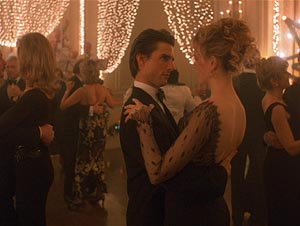 15 end |
16 LS Piano player on stage (4:01)
Cut to the pianist. It turns out Bill does know someone here (outside of his wife and himself and Ziegler, all of whom he presumably knows though as we get into the film we find that's not so certain).
A woman is observed dancing left into the frame, just as the cut is made to shot 17, who I will discuss shortly. She becomes a not infrequent and interesting element.
17 MS Bill and Alice dancing (4:09)
BILL (looking at the stage): You see that guy at the piano? I went to medical school with him.
ALICE: Really. He plays pretty good for a doctor.
BILL: He's not a doctor. He dropped out.
The music ends.
18 MS The band leader on the stage with his violin, the pianist beyond. (4:32)
BAND LEADER: Ladies and gentlemen, everyone, I hope you're enjoying yourselves. The band's going to take a short break now, and we'll be back in ten minutes.
19 LS The band leader and the band on the stage, a few dancers before it clapping. (4:40)
BAND LEADER: Thank you.
The band rises for its bow.
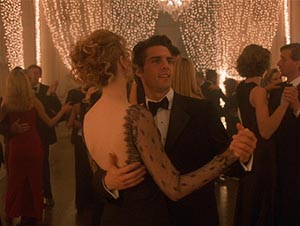
17 begin |
 17 end |
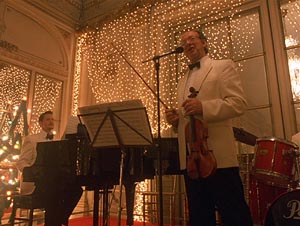
18 |
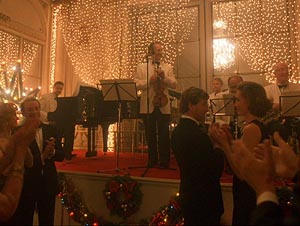 19 |
20 MS Bill and Alice clapping. (4:45)
Alice looks around, eager to get out of the room. Bill grabs her arm, his eyes still on the stage, as she moves toward the door, he following.
BILL: Let's go over and say hello to him.
Alice has no interest in meeting Bill's old friend. In a few seconds, as she exits and grabs a glass of champagne from the tray of a waiter, she behaves as if the waiter doesn't exist, not even glancing at him, much less thanking him, so I've the impression that Alice would not be interested in meeting the "help". But it may be that instead the impression we're supposed to have is only of her exasperation with the situation, being in a place where she knows no one, trailing along as Bill's wife.
ALICE: I desperately need to go to the bathroom. You go and say hello and I'll, uhm, I'll meet you where? At the bar?
BILL: Good.
Bill kisses Alice and she turns to exit screen right.
Alice is observed exiting behind a couple who had been occasionally dancing around them, and who are seen to the right of them in the shot where Bill kisses her. The man has silver hair and the woman is a brunette dressed in a purple jacket over a black dress. I am making note of them for a reason.
21 MS Alice exiting the ball room. (5:01)
The camera cuts from the ballroom to a view from the area into which they are exiting, and we see Alice having advanced beyond the aforementioned couple but the woman in the couple has changed, she is now a different person with shorter brunette hair and bangs and wears a black double-breasted dress. Also, rather than being on the man's right and his right arm embracing her, she is on his left and his left hand against her back. With Kubrick's interest in exploring ideas concerning doublings, it could be that the woman in the double-breasted dress references duplicities and is an expression of this being an intentional change rather than a continuity error. Note how she is also reflected (doubled) in the glass door.
An aside, a knee-length double-breasted suit dress seems rather an odd choice of attire for a party such as this, and I recollect that naval officers (a naval officer figuring prominently in the film) have not only their dress whites, which is what the officer wears later in the fantasy scenes with Alice, but also their blues, which have a double-breasted coat with two rows of gold-toned buttons. It may be the woman's dress for some reason refers already to the naval officer.
One might also be reminded of the Navy-inspired, double-breasted uniforms in Scientology's Sea Org.
The origin of the double-breasted coat is in the naval "reefer" (from reef and rib) coat, so-called for individuals who climbed the riggings of sailing ships. Or so it's said.
Another difference. Just before Alice exited the ballroom, the waiter who will serve her champagne can be seen standing on the left in the hall beyond. Now, outside the ballroom, the shot facing the ballroom, he should be on the right but instead is waiting on the left. This will seem, again, a continuity error, but if one reads through my other analyses, such as the one on 2001, one will be aware that Kubrick often does what amount to horizontal flips. This is the same, but far less obvious than those in 2001, as in 2001 the horizonatal flips are frequent and may involve the whole scene or the background, the first occurring with the appearance of the monolith. By the end of 2001, with the last appearance of the monolith in the bedroom, as the camera zooms in on it we find to either side of it a moment of perfect symmetrical mirroring. There may be an expression of this in the double-breasted dress that coincidentally occurs with the horizontal-flip in the physical orientation of the waiter.
Alice picks up a glass of champagne and pretty much slugs it down as she walks. This woman is not having a good time and is on her way to getting good and plastered.
We hear the strains of "It Had to Be You" by Isham Jones and Gus Kahn, from 1924.
Why do I do, just as you say, why must I just, give you your way
Why do I sigh, why don't I try - to forget
It must have been, that something lovers call fate
Kept me saying: "I have to wait"
I saw them all, just couldn't fall - 'til we met
It had to be you, it had to be you
I wandered around, and finally found - the somebody who
Could make me be true, and could make me be blue
And even be glad, just to be sad - thinking of you
Some others I've seen, might never be mean
Might never be cross, or try to be boss, but they wouldn't do
For nobody else, gave me a thrill - with all your faults, I love you still
It had to be you, wonderful you, it had to be you.
A number of party guests appear repeatedly but there are a few that stand out with intention. One, as already mentioned, is the silver-haired gentleman in these shots. We see in the above image another woman to the right who is easily and readily identified in shots because of the nature of her dress, it having 6 straps on each side crisscrossing in the back. She is also seen numerous times, always with her back to the camera, with the exception of a brief half-instant glimpse of the side of her face, in shot 16, as she dances before the bandstand when Bill first notices the pianist. I remark on this as the faces of others are shown, such as the face of the woman in the purple jacket was conspicuously displayed as she approached the ballroom door to exit into the hall, she even directly facing the camera. The face of the woman in the dress with the 12 criss-crossed black straps, however, is never directly observed and it may be because she is the one woman who resembles Victor's wife. Her hairstyle, figure and bearing remind of Illona, who we never see again throughout the party after she greets Alice and Bill before the grand staircase. To where has she disappeared? As she wouldn't have abdicated her place as hostess, it could be this other woman is intended to unconsciously bring Illona to mind for Kubrick positions her in such a way that she appears to communicate an air of authority, of being the hostess. Though she's out here in the hall as Alice takes her drink, she manages also to be concurrently in the ballroom as Bill introduces himself to his old friend, Nick, a reunion that should be taking place as Alice downs her champagne. In the below still from shot 22 the woman with the multi criss-cross straps can be seen directly behind Bill, her back to the camera.
To me, this woman who seems to have the bearing of a hostess, and reminds of Illona, is another expression of the idea of twinship and doubling, just as with the woman in the double-breasted dress who supplanted the woman in purple.
22 LS The pianist on stage with Bill below in the ballroom behind and beyond. (5:09). To be compared with shot 21 in which we also see the woman with the 12-strap dress in the background.
BILL (advancing): Nightingale! Nick Nightingale!
Nick Nightingale. What a name for a musician. And at Christmas! Nick! Will he be a Santa bearing gifts or a devilish sort? Should we think of the fairy tale of the emperor who for a time preferred the song of the mechanical nightingale to the real article?
And what of him sharing the name of Nicole Kidman, whose "nickname" is Nick, the name by which Tom Cruise calls her in interviews on his experience of working with Kubrick.
Freud wrote to Schnitzler, in 1922 (the letter published in Time magazine in 1957), "I think I have avoided you out of a kind of fear of finding my own double..." It's been suggested that Freud was loathe to meet Schnitzler due to the legend that if one met one's doppleganger then one would cease to exist.
NICK: Oh, my god, Bill! (Leaping down from the stage.)
23 MS Bill before the stage, the cut catching the pianist in mid leap from the perspective of the ballroom. (5:16)
NICK: Bill Harford! How the hell are you, buddy?!
Bill and Nick (Todd Field) shake hands and clap each other's shoulders, Bill looking genuinely pleased.
BILL: How long has it been?
NICK: Oh, geeze, I don't know. Ten years?
BILL (laughing): A couple. You have time for a drink?
NICK: Sure!
Bill claps his arm around Nick's back, walking with him away from the stage, and again erupts in laughter, Nick joining. He slaps Nick's stomach.
BILL: You haven't changed a bit.
NICK: Oh, thanks. I think. How are you doing?
BILL: Not too bad, y'know.
NICK: Yeah?
BILL: Not too bad. I see you've become a pianist.
NICK: Oh, yes, well, my friends call me that. How about you? You still in the doctor business?
BILL: You know what they say. Once a doctor, always a doctor.
NICK: Yes, or in my case, never a doctor, never a doctor.
Bill takes two glasses of champagne from a waiter and hands Nick one.
BILL: I never did understand why you walked away.
NICK: No?
A man begins to approach Nick from the right, his eye on him.
NICK: It's a nice feeling. I do it a lot.
BILL: Cheers!
They clack glasses in a toast and raise their glasses to drink.

ZIEGLER'S PERSONAL ASSISTANT (before Nick has a chance to drink): Excuse me. Nick, I need ya a minute.
NICK: Be right with ya.
The assistant exits to the right.
Nick has said he walks away from things a lot, and immediately he is called away, which is the first of the many interruptions Bill will experience.
One wonders for what reason Ziegler's personal assistant would be needing the pianist rather than the band leader? In band world, for what it's worth, this wouldn't happen. Band business will involve the leader, which Nick is not.
If one looks up the actor who plays Ziegler's assistant he was seemingly most notable as being an assistant to Tom Cruise on a number of films during a time when Cruise was said to be estranged from Scientology, the assistant performing as the intermediary (or spy, some say) who daily delivered reports on Cruise to Miscavige.
As Nick serves somewhat as an agent of "temptation" for Bill, a kind of Mephistopheles, I am reminded that in the book of Job, Satan (as in an opponent or adversary) is given as, "going to and fro in the earth, and...walking up and down in it."
We will eventually find all these characters blending together.
NICK: Listen, I gotta go do something. Uhm, if I don't catch you later I'm going to be down in the village for two weeks at a place called the Sonata Cafe. Stop by if you get a chance.
BILL: I'll be there.
NICK: Yeah.
BILL (slapping Nick's arm): Great seeing ya.
NICK: Yeah, good seeing you too, man.
Kubrick has taken the book's scene in which Fridolin (Bill) meets Nick and split it into two. In the book, there is one reunion before the orgy, occurring at a cafe into which Fridolin has happened and where Nick is playing. It is during that meeting that Fridolin finds out about the party where Nick will be playing blindfolded and insists upon going. To follow the book more closely, Kubrick could have left it so that Bill happened upon the Sonata Cafe and there met Nick for the first time. Instead, he has elected to bring Nick into Victor's party, where Alice could have met him as well but chooses not to do so.
24 MS crossfade to Alice at the bar. (6:22 Begin crossfade and end at 6:28.)
Crossfade to Alice in another similarly decorated room, standing before a long white-draped table, bar to the rear. She is alone, drunk, waiting for Bill who promised to meet her there. With the crossfade, she is briefly positioned so that she appears to be standing next to Bill who is in the ball room, Nick having just left him.
The crossfade seems to intentionally catch Bill in an unflattering boyish light, he again bringing up the rear to Alice/Nic, she brooding, he unaware of this aspect of her.
Alice is all dressed up with no one to talk to, at a party where she knows no one, at a party she'd prefer not to be attending, only present because of her husband.
The camera revolves to the right around her, stopping behind the bar, facing her back. She places her left hand on the table behind her, and though she's struck a pose, she is also drunkenly bracing herself against the table. A man to screen right, who was speaking to another woman, turns and faces Alice, taking notice of her, she appearing to take no notice of him. He places his drink down and turns back to her.
But she is aware of his presence in the periphery of her vision.
Sounds of milling party conversation have been brought up in the mix. As the Hungarian turns to Alice, having placed his drink down on the table, Alice certainly well aware of him but pretending ignorance, we hear a woman remark, "To a different bed."
He watches as Alice now stretches her right hand to find the table without looking back and places her glass of champagne on it in a particularly languid manner.
The man picks up Alice's drink. At the same time she calculatedly reaches for it, without looking, thus meeting his hand. She turns to face him, an opportunity for an encounter, though she feigns innocence, and he well aware of the flirtatious artifice.
ALICE: Oh, I think that's my glass.
He closes in on the solitary and obviously bored woman and oily replies.
SANDOR: Oh, I'm absolutely certain of it.
Sandor (played by Sky Dumont) smiles and drinks the rest of Alice's champagne as she watches.
Alice leans back against the table, softly smiling at him, as the last bits of "It had to be you" play out.
Another song begins.
SANDOR: My name is Sandor Szavost. I'm Hungarian.
He takes her hand and kisses it.
25 MS Alice and Sandor, the camera facing the bar. (7:37)
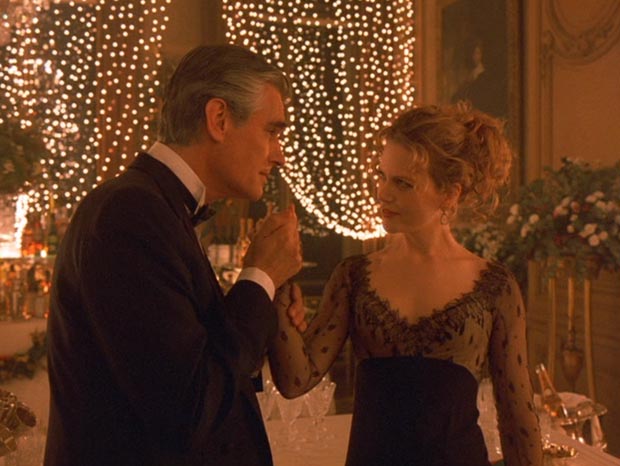
ALICE (tipsily flirtatious): My name is Alice Harford. I'm American.
SANDOR: Delighted to meet you, Alice. Did you ever read the Latin poet, Ovid, on the art of love?
Ovid gives as a technique of seduction the drinking out of the same glass routine that Sandor has just employed, so we have here Sandor going by the book, by formula, in his attempted seduction of Alice.
I wouldn't be surprised, however, if Ovid is brought in due his authorship of the Metamorphoses. Per Wikipedia, "The work encylopedically catalogues transformations in Greek and Roman mythology, from the emergence of the cosmos to the deification of Julius Caesar. The stories follow each other in the telling of human beings transformed to new bodies: trees, rocks, animals, flowers, constellations etc." As already noted, Kubrick has protean shifts in his films from the time of Fear and Desire.
ALICE: Didn't he end up all by himself, crying his eyes out in some place with a very bad climate? (Laughs.)
SANDOR: But he also had a good time, first. A very good time. Are you here with anyone tonight, Alice?
ALICE: With...my...husband.
SANDOR: Oh, how sad. But I'm sure he's the sort of man who wouldn't mind if we...danced?
Later, Alice will furiously deride Bill for his lack of jealousy, and Sandor helps plant the seed for that fury, assisting to bring it to the fore.
In the Tarot, the Art card (Temperance) and the Lovers (Gemini) are complementary cards, Art concerning the consummation of the Royal Marriage that was observed in the Lovers card. Associated with Temperance is the arrow of Sagittarius piercing the rainbow. The following dialogue of Sandor and Alice, while they dance, suggests a failure of Art or Temperance and a rectification, rectification having all to do with this card. We are also in the appropriate season, for Sagittarius occurs in the zodiac from November 23rd to December 21st.
26 MS Crossfade to Sandor and Alice dancing in the ball room. (Begin crossfade at 8:32, end at 8:37.)
The crossfade has Sandor melding almost perfectly with the Sandor who dances with Alice.
The crossfade also has, through the superimposition, Alice and Sandor kissing, the lips of the dancing Alice brushing those of the Sandor who has just asked her to dance, two different time periods interacting. The position of the star behind them, during this kiss, caused by superimposition, recalls the star against the wall that figured so prominently during the scene when Bill and Alice were speaking with Victor and Illona before the statue of the angel's kiss.
Other than the statue that was observed by the stairs where Alice and Bill met Victor and his wife, this is the first sexual kiss of the film, however superimposed. Also, nearly all the other dancers are somewhat stiff, most of them less dancing with each other than moving around the room to the music, and they don't usually look at each other, more often staring into space or glancing about at the room around them. Alice and Sandor instead embrace as they dance, she held against him, and they stare into the eyes of one another continually, he utterly absorbed in his attempted seduction and Alice utterly absorbed in the attention he is giving her and her flirtation with him.
SANDOR: What do you do, Alice?
ALICE: Well, at the moment I'm looking for a job. I used to manage an art gallery in Soho. But it went broke. (She giggles.)
Which explains all the art in her home, her interest being in art. Not to mention they are the paintings of Kubrick's wife, Christiane, who is a fine artist. That Alice is currently without a job, is now Alice the mother rather than Alice the art gallery manager and mother, must fuel her insecurity.
SANDOZ: What a shame. I have some friends in the art game. Perhaps I can be of some help.
ALICE (purrs): Oh, thank you.
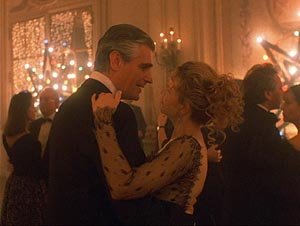
26 begin |
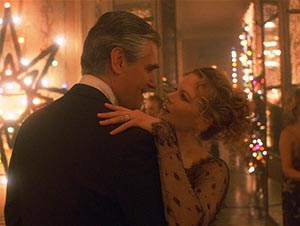 26 end |
27 LS Bill with two women in an adjoining hall. (9:10)
Cut to a long shot of Bill standing with two women in a room adjoining the ballroom. One is a brunette in a long burgundy-rose-colored lace dress with short sleeves (a snowflake pattern) and the other an ash blond in a short silver-green sequin number. Beyond them hang the type of decorative bows that we will later see at Sharky's.
A man and woman, seen on the left, dance into the scene, seeming to be in the same hall as Bill.
The couple who had danced into the scene, seeming to be in the hall with Bill, disappear from view as a couple in extreme close-up immediately passes through the foreground in the ballroom where Alice is. They are both the same couple though we may not recognize it, the pair that had appeared to be in the same room as Bill being but a reflection of the couple that dances past in the foreground. Rather than being in the hall they are actually in the same room as the camera.
We had earlier observed the woman in the dress with the black straps in two places seemingly at once, and here we have the dancing couple seemingly in two places at once, but one of those couples was only a reflection, a mirroring. An overt instance of doubling.
An exercise in displacement in space, a thing appearing to be where it is not.
The dancing couple in the foreground quickly passing, there then enters from the left into the hall the woman in the dress with the criss-cross black straps and a man.
Indeed, they enter where we would anticipate the dancing man and woman continuing (though the dancing couple would be closer in the foreground) had they been in the hall rather than reflected. We will shortly see this woman also dancing in the ball room (shot 28), which means this is twice now we've observed this woman with the criss-cross straps inhabit two places at once, the other time being when Alice exited the ball room and tipped back a whole glass of champagne while Bill approached Nick who was still on stage. Concerning these doublings as well as many of the peculiarities in Kubrick's films, many will assert these are only continuity errors, but the dancing couple seems a comment on nature of these doublings, given just as the often doubled woman in the criss-cross strapped black dress enters the frame.
What is real and what is its doppelganger reflection? Which possesses more substance, the physical or the spiritual twin? Alice later relates to Bill an infidelity that never happened, and a dream in which she betrayed him. He is profoundly affected by both, as if they may have been reality.
The man we see with the criss-cross woman seems a kind of double for Bill. We only view him from behind, just as we only see the woman from behind. His hair is slightly different, but his bearing is much the same as Bill's.
28 MS Alice and Sandor dancing. (9:19)
Cut back to Alice noticing Bill with the models.
SANDOR: Someone you know?
ALICE: My husband.
SANDOR: Don't you think one of the charms of marriage is that it makes deception a necessity for both parties?
Ah, baiting Alice into jealousy.
The duplicitous woman in the criss-cross black straps dances behind Sandor and Alice just after we had observed her near Bill, Alice doesn't answer that question. She laughs, and Sandor continues.
SANDOR: May I ask why a beautiful woman, who could have any man in this room, wants to be married?
ALICE: Why wouldn't she?
SANDOR: Is it as bad as that?
ALICE: As good as that.

28 begin |
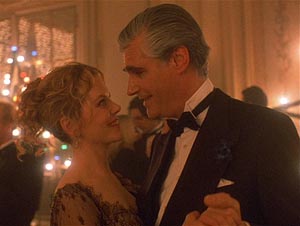 28 end |
I'll take a moment to note here that what one can't begin to imagine in the screen grabs is the motion had, the constant revolutions of the camera with the dance, which takes us back to 2001 and the revolutions had with the waltz of the satellites.
29 MS Nuala (the brunette) and Gayle (the blond) and Bill. (10:14)
The music that has been playing ends as we cut to the ash blond woman asking if Bill knows Nuala Windsor.
GAYLE: Do you know Nuala Windsor?
BILL: No, no, and it's very very lovely to meet you. (Her arm wrapped around Gayle's neck, he shakes her hand, and they laugh, clinking glasses.) How do you spell Nuala?
NUALA (leaning in close to him): N-U-A-L-A.
GAYLE: You don't remember me, do you?
Bill: Uhhmmmm...
GAYLE: You were very kind to me once?
BILL: Only once? That sounds like a terrible oversight.
GAYLE: I was doing a photo session...in Rockefeller Plaza? On a very windy day?
BILL (remembering): You had something in your eye.
GAYLE: I did. Just about half of Fifth Avenue.
BILL: Right.
GAYLE: You were such a gentleman. You gave me your handkerchief. Which was also clean.
BILL: Well, that is the kind of hero I can be...sometimes.
Everyone has a little laugh over that being just the kind of hero Bill can be...sometimes...rescuing Gayle with his clean handkerchief.
Just as the shot closes, the woman who we'd earlier observed in the double-breasted dress passes by with a gentleman, followed by a waiter with a ponytail, and then we've a brief glimpse of the woman with the 12-strap dress behind him, following up alone, but we don't view the 12 straps, only her in profile. I believe this is the last we see of her.
Not to be unceasingly obnoxious in bringing up differences in set where there should be none, if we compare the above image of Bill, Nuala and Gayle to when Alice was watching the three, we will we observe that the mirror on the left wall in the first scene of the three appears to no longer be there, and that there may instead be a mirror on the right wall beyond. Also, the star that was beyond Bill in that first scene has disappeared.
Not only does this switching occur, but in the scene with the discussion of the handkerchief we are afforded a brief glimpse of an architectural detail that we don't observe elsewhere in these halls, the half wagon-wheel arch leading into the area with the two bows. I'm uncertain if this may also be called a fanlight, which we will later see above a door on a facade during the scene in which Bill is accosted by the frat boys, another fanlight seen also at Somerton. I've read that a fanlight can represent the rising sun. However, in the April 1916 issue of "The Craftsman", the architectural arch is given as...
...the symbol of the heavens that curve above the earth and of the rainbow of light and promise...
And we are rapidly approaching that scene in which Nuala and Gayle invite Bill to the end of the rainbow.
Windsor is the name of royals, but we perhaps have some punning here with the windy day, Bill being introduced to a woman named Wind-sor, and Gayle (gale, as in a wind) being the one who had all of 5th avenue in her eye. Also, perhaps word play with it having happened in Rockefeller Plaza, ruach being "wind" in Hebrew, sometimes being the divine wind of the holy spirit.
The name Gayle also refers back to Nick Nightingale. Etymonline gives "gale" as from the Old Norse galinn, meaning "bewitched", though it also states the word could be from instead the Old English galan, meaning "to sing".
In the screenplay, Nuala is given as an "agency" name, itself a mask intended to communicate a certain aura.
The clean handkerchief returns us to Bill's looking for his wallet, going to the dresser and taking from it a white handkerchief before locating his wallet, with Alice's direction, on the bedside table.
The scene brings to my mind the following from the Gospel of Matthew, which will not be without relevance.
Or how wilt thou say to thy brother, Let me pull out the mote out of thine eye; and, behold, a beam is in thine own eye?
Or, Physician, heal thyself.
In the bedroom a connection is already made between that handkerchief, used for rescuing women such as Gayle, and Bill's inability to see his own wallet.
So, why the coming smack down from on high of Bill the good doctor and family man? One of the few back stories of Bill in the film is this clean handkerchief used in a good deed. The only other two back stories are his former acquaintance with Nick Nightingale in medical school, and Alice's account of the vacation during which she had seen the naval officer.
In many respects, Bill is blithely and even foolishly innocent. As the good doctor with an insight on the highly personal business of others, that innocence combined with privy information puts him in the position of becoming less a respected, experienced counselor than a too well-scrubbed nearly perfect (despite his flaws) accuser. His Achilles heel, the beam in his eye, is not any type of easily identified hypocrisy but his confidence and, by extension, his blindness, else he wouldn't be so easily floored by Alice's later confession. While she is seriously flirting with Sandor, boyish Bill is easily out of his league with Nuala and Gayle; one of the last things we could imagine him doing is seriously contemplating sex with them, much less doing it, though he doesn't mind being teased and casually flirting in turn. As far as he is concerned, he can be safely teased and engage in teasing because he's not a risk. He is curious, but safely not seriously curious. If this wasn't so, his later contemplation of infidelity with Domino wouldn't be for him as loaded and transgressive a situation as it appears to be.
We should keep in mind this incident concerning the eye during Bill's later altercation with the frat boys. In the film, Bill seems to be a general practitioner. Instead, in the book Fridolin was not only an eye specialist, but when he has his own altercation with several members of a rowing team one of them has a bandage covering his eye.
Another thing before pressing on. When Sandor speaks of the "charms" of marriage, I'm inclined to wonder if there's the slim possibility that here is where we find in Eyes Wide Shut the CRM-114 of Dr. Strangelove and the Serum-114 of A Clockwork Orange. Though it doesn't occur with 114 it is only a few seconds before 10:14, when we make our second cut to Bill and Nuala and Gayle, and Bill's casual flirtation with them, which is begun and pursued by the women. This is Bill's beginning introduction to the end of the rainbow, the onset of his confusing adventure. (I will probably trash the idea about CRM expressed in charm.)
30 MCU Alice and Sandor dancing. (11:07)
SANDOR: You know why women used to get married, don't you?
ALICE: Why don't you tell me?
SANDOR: It was the only way they could lose their virginity and be free to do what they wanted with other men, the ones they really wanted.
Sandor is suggesting that Alice may be in the same situation, really wanting someone other than her husband. But his assertion is later denied by Alice's story of the officer, her compulsion for him having been of such an intensity that she was willing to throw her marriage aside and so it was a great relief to her that he left before anything could happen.
ALICE (she laughs after a pause): Fascinating.
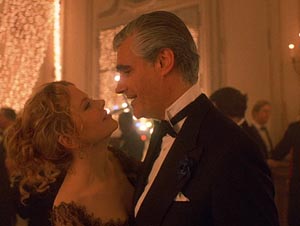
30 begin |
 30 end |
31 MS Bill walking toward the camera with the models draped seductively on either arm, Nuala on screen left (his right) and Gayle on screen right. (11:35)
GAYLE: Do you know what's nice about doctors?
BILL: Usually a lot less than people imagine.
GAYLE: They always seem so knowledgeable.
BILL: Oh, they are very knowledgeable about all sorts of things. (He looks at Nuala.)
GAYLE: But I bet they work too hard. Just think of all they miss.
BILL: You're probably right. Now, ladies, where exactly are we going? Exactly? (He laughs.)
Shades of The Shining, all work and no play make Jack a dull boy.
GAYLE: To where the rainbow ends.
BILL: Where the rainbow ends.
NUALA: Don't you want to go where the rainbow ends?
BILL: Well, now, that depends where that is.
Victor's butler has entered from screen left, his eye on the scene.
GAYLE: Well, let's find out.
THE BUTLER: Excuse me, ladies. Sorry, Dr. Harford, sorry to interrupt. I wonder if you could come with me for a moment. Something for Mr. Ziegler?
BILL (looking at the women): Oh..uh...fine. (To the women.) To be continued...?
Bill may look enthusiastic in the above still, ready to go off with the women, but he's not. He had put on the brakes, willing to only go so far with the women. He may say "to be continued" but only because the butler has rescued him. Yet in his saying "to be continued" he has unwittingly accepted the challenge and will thus be propelled into his adventure.
Commenter Yoyonovich remarked that she sees a resemblance between Georgie Boy and Dim leading Alex to the trough, in A Clockwork Orange,, and the two models in Eyes Wide Shut inviting Bill to go to where the rainbow ends. A correspondence between these pairs had never struck me before but when I return to check out the scene of Alex being led through the path in the woods I recollect we have there a couple of very strong rainbow lens flare effects. I had previously chalked this up to just lens flares but she may instead be right and that we have there as well a rainbow reference.
The demeanor of the women becomes peculiarly and suddenly serious as Bill leaves them.
32 LS Bill and Ziegler's butler ascending the staircase. (12:54)
Bill and the butler ascending the grand staircase, two couples now are seated at the foot of it before the statue of the angel's kiss. The woman in the green top on the right, and the man on the left, are a couple who had followed Bill and Alice into this area from the hall upon their arrival, followed up by the man on the right who had been with a younger woman. The man on the right, in the glasses, is the one in the #14 crossfade who had appeared to be approaching a non-existent door in the hallway between this area and the ballroom. Here, his collar and bowtie meet in such a way that he is given the appearance of having a priest's collar. This is notable as above the stairs is an open grating in the balcony of the floor above that reminds somewhat of a scene later at the "orgy", when Bill is having his confrontation with the hierophant and the black feather woman appears on the second floor, in a framing reminiscent of the balcony here, to offer herself in Bill's stead--the same woman that he is at this moment on his way up to see in Ziegler's bathroom.
At the end of the analysis, I further explore these several individuals seated beside the Cupid and Psyche statue.
Bill is knowledgeable but it's implied his understanding doesn't match the knowledge he possesses. He misses much.
With the beginning of the rainbow adventure, we've a commentary of sorts on Bill's earlier remark concerning the clean handkerchief to the rescue, on that being just the kind of hero he can be sometimes. The word hero (demi-god) comes originally from the same root that gives us the Latin servare, "to save, deliver, preserve". Observe also comes from this via the notion of "see and note omens". Bill is about to stumble into a world where omens can be observed everywhere through everything being connected.
Speaking of signs and omens, we call it the "rainbow", the sign that is given as having been placed in the heavens by God as a curious and rather inexplicable reminder to itself never to flood the earth again and wipe out all creatures--as if deity is so senile as to "forget" and impulsively exterminate life, but so it's said. In Genesis, that rainbow is simply given as a bow, the Hebrew for which is QShTh, a bow for shooting (strength)...or the iris of the eye (which I've always thought was interesting and kind of wonderful). QShTh is given as coming from the word QShSh, to be severe, and QVSh, meaning to bend, to snare. The bow has already been brought in via the time of year, Sagittarius, perhaps an association with the Art/Temperance card of the Tarot, and certainly has been observed physically in the two bows overhanging the hall between the grand staircase and the ball room.
14 And it shall come to pass, when I bring a cloud over the earth, that the bow shall be seen in the cloud: 15 And I will remember my covenant, which is between me and you and every living creature of all flesh; and the waters shall no more become a flood to destroy all flesh. 16 And the bow shall be in the cloud; and I will look upon it, that I may remember the everlasting covenant between God and every living creature of all flesh that is upon the earth.
With the story of the flood there enters the character of Noah, at least in the Christian and Jewish versions. A relationship, of sorts, exists between Noah and Chanukah, the time of year that this movie takes place. ChNKH means initiation, consecration, coming from ChNK, to initiate or discipline, train up. Its first two letters are ChN, meaning grace, favor. In the story of Noah he is given as having found "favor", ChN, in the eyes of the Lord, which is the first time ChN appears in the Torah. NVCh (Noah) means to rest, settle down, and is closely associated with the idea of home. What we see with NVCh finding favor, ChN, is close to a form of permutation, the letters reversed. Indeed, Chanukah is related to Noah through the olive oil pressed from the branch he received from the dove, that branch being the sign that the flood waters had receded. The oil used for the Menorah is connected to that oil, though interpretations of how this is so vary.
The rainbow was set in the cloud, ONN, which is from a word meaning to cover, cloud over, act covertly, practice magic. ONH, in Hebrew, is the eye. The Hebrew letter O, or OYN, is the eye. So what we have here with the cloud is the eye, ONH, which has undergone a change with ONN.
To where the rainbow ends? Kubrick has called attention to the name "Nuala", with her spelling it for him, leaving out the name of the second woman which we only have through the credits. The word, NLH, in Hebrew, means to complete, make an end. If there is a correspondence between Nuala and NLH, it's interesting that the woman inviting him to where the rainbow ends has a name similar to NLH meaning "complete, make an end".
QShTh being the bow of the covenant, QShT or QShVT means fidelity, truth, given as corresponding to QShT, to balance, equity, reality. So, here in the rainbow itself we have the later password, fidelity, which gives Bill entrance to Somerton. This seems to me to be of significance.
THE OVERDOSE
THE SWITCH FROM THE TWISTED LAMP COLUMN AND RED PHONE TO THE DRUG PARAPHERNALIA AND A DIFFERENT LAMP - AN UNDERSTANDING
33 LS Victor and Amanda in bathroom. (13:02)
Twice now Bill has been interrupted, first with Nightingale and then with Gayle and Nuala. This time the interruption is via Ziegler's butler and carries him up the stairs beyond the "Love of Angels" statue.
Cut from the golden light of the party to Victor in a palatial bathroom, zipping up his trousers, otherwise unclothed, a champagne bottle in a bucket behind him, a nude woman in high heeled sandals passed out in a burgundy armchair, sky blue lingerie on the floor to the side beside a stack of books. The sky blue lingerie matches a Chinese dragon that is one of twin dragon decorative elements on a nearby fireplace. Above the fireplace is a large painting of a nude pregnant woman resting on Oriental rugs.
The painting of the pregnant woman suits the season and the birth of the new year, and several times in the film we see a pram or stroller. Towards the film's end we even have Helena drawn to an "old fashioned" pram in the toy store.
Behind Victor is a small round table with a red phone on it. This will change.
There's a knock on the door.
VICTOR: Yeah!
Victor jogs for the door at which is Bill and Victor's butler.
VICTOR (letting in Bill, shaking his hand and closing the door): Bill, thanks for coming.
"Thank you for coming" is how Illona, Ziegler's wife, had earlier greeted Bill and Alice.
BILL: Oh.
VICTOR: Had a...had a little accident here.
BILL (kneeling beside Amanda): What happened?
VICTOR: Well, she was, uh, she was shooting up...
34 MS Amanda on the armchair, Bill kneeling beside her. (13:26)
VICTOR: And she, she had a bad reaction.
BILL: What did she take?
35 MCU Victor before the painting of the pregnant woman. (13:32)
VICTOR: Huh, speedball or snowball or whatever they call it, you know, it's, it's, it's heroin and coke.
36 MS From behind Victor's left arm, profile from Amanda's left side, Bill holding her chin. (13:38)
Bill opens the woman's left eye and examines it. A parallel can perhaps be drawn between this and the scene in The Shining, post Danny's vision, he having fallen unconscious, where the camera returns from darkness to the doctor examining Danny's eyes, asking him to open them so she "can see". In A Clockwork Orange we have the sections in which Alex's eyes are pinned open, and there is also a period of blackness with Alex's suicide attempt dive from a window, after which he wakes from his coma in the hospital. In Lolita, Humbert's eyes are examined by a doctor when he pitches a fit and is wrestled to the floor upon finding that Lolita has left the hospital with her supposed uncle. The eye exam is a theme repeated in several of Kubrick's films.
Change of props. After Victor having described what the woman had taken, we now see again the round end table behind Bill and the red phone is absent. Instead there is drug paraphernalia. It hadn't been there previously.
BILL: Heroin and coke. (He opens her mouth and looks inside.) Anything else?
We may have a little wordplay with the heroin and coke, for the woman at the orgy who takes Bill's place could be looked upon as a kind of heroine by him. The idea of the hero has already been raised with Bill and his having been such by seeing to the model's eye and helping her with the clean handkerchief. Hero comes from the root ser-, "to watch over, protect", the Latin Servare being "to save, deliver, preserve, protect", which I've previously noted. Heroin, as in the drug, is said to come from the word "hero".
37 MCU Victor before the painting. (13:50)
VICTOR: We had a couple of drinks. Nothing, really. Some champagne, that was it.
38 MS From behind Victor's left arm, Amanda and Bill. (13:53)
BILL (holding Amanda's wrist, checking her pulse): How long has she been like this?
39 MCU Victor before the painting. (13:55)
VICTOR: Not, not long. Maybe five minutes, six minutes, something like that.
40 From behind Victor's right arm, MCU Amanda and Bill. (13:58)
BILL: What's her name?
41 Victor before the painting. (14:00)
VICTOR: Uhm, Mandy. Mandy.
Bill, who had minutes before been deeply engaged with flirting with two lovely women, immediately and easily puts on his doctor persona, takes the woman's hand, attempts to call Mandy back (Amanda, Mandy, meaning "loved", coming from amor), asking her if she hears him, his gaze less avoiding her nudity than overlooking it, as if he simply does not see it as it is of no significance in this context, she being first a patient, a human, then a woman, and not a sexual object. Can she hear him? She can? Can she open her eyes for him? He calls her to open her eyes and look at him.
42 MCU from behind Victor's right arm of Amanda and Bill. (14:04)
Amanda murmurs words that are insensible.
BILL: Mandy. Mandy? Can you hear me, Mandy?
She murmurs a sentence that we can't hear.
43 MS Amanda and Bill from the front. (14:15)
BILL: Can you hear me? Just move your head for me if you can hear me. Just move your head for me if you can hear me, Mandy. There you go. You can hear me. Can you open your eyes for me? Let me see you open your eyes. There you go. Come on, come on, look at me. Look at me. Look at me. Look at me.
Amanda, who has been struggling to move her head in Bill's direction, then struggling to open her eyes, manages to open them a little, Bill calling her back.
44 MCU From behind Victor's right side, Amanda and Bill. (14:40)
BILL: Look at me. Look at me, Mandy.
Amanda murmurs something.
BILL: Good. Good.
 34 |
 35 |
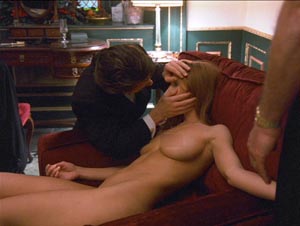 36 |
 37 |
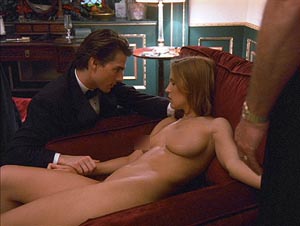 38 |
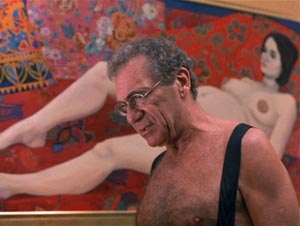 39 |
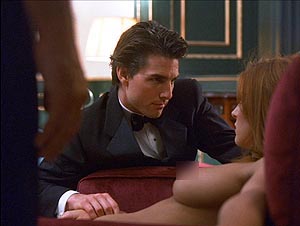 40 |
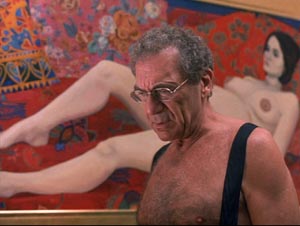 41 |
 42 |
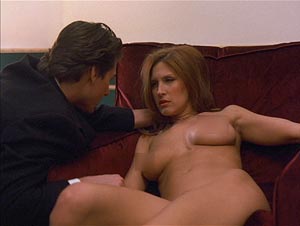 43 |
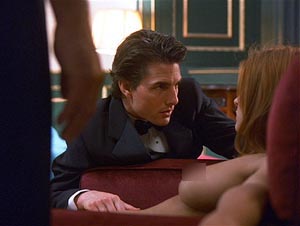 44 |
|
The cuts take us back and forth from Amanada and Bill to Victor against the painting, the pregnant woman's legs in the painting, her posture, recalling Amanda. With the ballroom shots, we don't have the back-and-forth dialogue shots as the camera is continually circulating with and focusing on a dancing couple. This is the first long exchange of a dialogue sequence in the film.
With shots 40, 42 and 44 we may feel that we're seeing the corner angle of the room beyond Amanda's chair, but we are actually viewing past Bill to the opposite corner angle in the window alcove next the bidet.
45 MCU Sandor and Alice dancing. 14:51
In the meanwhile, Alice and Sandor are waltzing to "When I Fall in Love" by Victor Young and Edward Heyman.
When I fall in love it will be forever
Or I'll never fall in love
In a restless world like this is
Love is ended before it's begun
And too many moonlight kisses
Seem to cool in the warmth of the sun.
When I give my heart it will be completely
Or I'll never give my heart
And the moment I can feel that you feel that way too
Is when I fall in love with you.
Sandor, in the ballroom, is looking up to screen right. A connection is thus made between his conversation with Alice and what is transpiring upstairs. This is very similar to the visual dialogue of shots 7 and 8, in which we see the man on the sidewalk bench in shot 7, and then in shot 8 we have Bill looking out the window in the seeming direction of the man on the bench.
SANDOR: I love Victor's art collection. (His eyes return to Alice's.) Don't you?
ALICE (nodding her head): Yes, it's wonderful. (She leans her face in close to his, their lips not far apart.)
SANDOR: Have you ever seen his sculpture gallery?
ALICE: No, I haven't.
SANDOR: He has a wonderful collection of Renaissance bronzes. Do you like the period?
ALICE: Mmmmm. I do.
SANDOR: I adore it. The sculpture gallery is upstairs. Would you like to see it? I can show it to you.
Renaissance means to be born again, and upstairs on the second floor we've just observed the painting of the pregnant woman in Victor's bathroom where Bill revives Amanda.
Past the point of flirting for only social fun and games, Alice's mouth close to Sandor's as if receptive to a kiss, she lingering on her response, perhaps considering, Sandor pushes for a decision with an ill-played move.
SANDOR: We won't be gone long.
ALICE (coy but letting him know that was the wrong thing to say): Maybe...not...just...now.
The Hungarian has not overtly proposed a sexual liaison but he has made a proposition. One could say he is communicating through a double language, the suggestion of their going up to take a look at the Renaissance sculpture gallery being understood as an invitation to an affair. It is not, however, explicitly stated. Cloaked, it may only be understood between the two and not to exterior ears.
Alice's response is long, drawn out. The "Maybe..." is slow and lingers. With the following "not...just...now" I have always heard this as a "no", but it is actually a little more ambiguous than that.
46 LS from behind the freestanding bathtub of Victor dressing. (16:06)
Return to the bathroom. Victor has his shirt on. Mandy is covered with a blue towel, her legs drawn up in the easy chair. Bill looks on from his seat on a nearby secretarial desk. Victor stops before Mandy.
It's now we clearly see the twin Oriental dragons flanking the fireplace. Once again, we have the blue lingerie resting beside Mandy in her wine-colored chair. Where is her outer clothing? Is it the white garment that is carelessly hanging on the side of the bidet? This looks more like lingerie as well and it's difficult to imagine that Mandy would have worn this white garment alone over the blue lingerie to her side. Where is her dress?
Props change. The appearance of the mantle has changed slightly. Two small green vases, a stack of books and some other items are no longer to be seen.
The undulating waves of the legs of the woman in the painting we now realize are echoed in the tail fins of the dragons. The wave is a motif in the film. For instance, we find it also in Bill's office with the receptionist counter and the seating in the waiting room.
VICTOR: That was really one hell of a scare you gave us, kiddo.
In other words, "I don't care what you do on your own time, but it would be rude of you to die in my nice bathroom and slightly inconvenience my life."
AMANDA: Sorry.
BILL: How are you feeling now, Mandy?
AMANDA: Better.
We are intended to hear "better" but the "e" of the first syllable could be confused with "bitter".
47 MS Bill seated on the desk. (16:45)
He stands and crosses over to squat beside her, taking her arm.
BILL: You are a very, very lucky girl.
Lucky to be alive...
This little phrase is a significant one which, by the end of the film, will be fired back at Bill with a bit of a twist.
48 MCU Amanda from behind Bill's right arm. (16:58)
BILL: You know that?
AMANDA: I know.
49 MCU Bill from the left of the easy chair in which Amanda is seated, Victor beyond. (17:04)
BILL: You're gonna be okay this time, but you can't keep doing this.
Amanda's and Bill's situations seem so far apart they can't be compared but the warning he gives her is not too dissimilar in spirit, even if the tone of delivery is not the same, from the warning he later receives to not further inquire as to what happened at Somerton. Stop now. You've gone too far. Don't do this again. You risk your life.
50 MCU Amanda from beyond Bill's right arm. (17:12)
BILL: You understand.
AMANDA: Yeah.
51 MCU Bill from beyond the left of the easy chair. (17:18)
BILL: You're gonna need some rehab. You know that, don't you?
52 MCU Amanda from beyond Bill's right arm. (17:23)
AMANDA: I know.
We notice a large fake pearl ring on her left hand. It is likely what is called a "poison" ring with a secret compartment.
53 Bill from the easy chair's left. (17:26)
In shots 51 and 49, Victor is slightly out-of-focus, standing behind Bill. His arms are raised, as if he is tying his bow tie, but for most of the time that Victor is observed he and his arms are absolutely still, which is odd but it also makes Victor almost invisible though present, more like a mannequin. Sidney would have had to have been instructed to keep stock still. In shot 54, Victor's arms are finally relaxed, he moving them.
"Why" is not answered but context is perhaps provided when one refers back to Victor's Renaissance bronzes and then leaps ahead to the mannequins at Rainbow fashions who will look "like live", some even defying their paralysis and moving about, just as other props may move about, but the idea of the prop now anthropomorphized through the mannequins, and related to even the actors.
Bill is usually the one that, in this film, gets the close-up treatment while everything in the background is somewhat blurred or bokeh, and there are other instances in the film where individuals in a soft-focus background hold a static position for an unrealistic period of time.
BILL: Okay. (He smiles.) Okay.
He pats her arm twice in a reassuring bedside manner that closes the deal of their understanding.
 48 |
 49 |
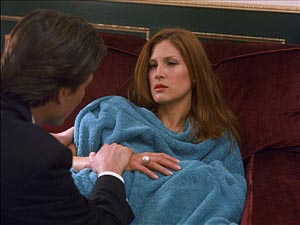 50 |
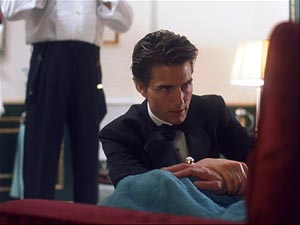 51 |
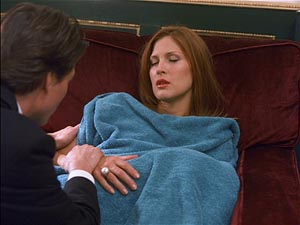 52 |
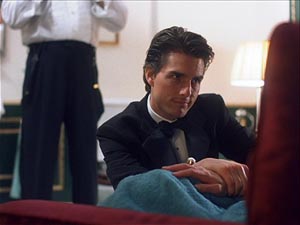 53 |
54 MS Bill rising. (17:35)
BILL: Well, Victor, I think I can leave the rest to you.
VICTOR: Is it okay if I get some clothes on her and get her out of here?
BILL: Uhhh, no, I'd keep her here for another hour.
VICTOR: Another hour. (Distressed, he looks at his watch.)
BILL: Then I'd, well, I'd have someone take her home.
VICTOR (nodding his head): Okay. Okay.
BILL: Goodnight, Mandy.
Mandy raises a finger and grunts in response as Victor walks Bill to the door.
VICTOR: Listen, uhm, I can't thank you enough for this, you saved my ass.
Perhaps a silly thing to note, in the mirror on the desk we see Victor's black coat reflected, draped over the back of a chair. For the life, of me, I've never been able to figure out what the white plane is bisecting the bottom portion of the mirror. This was seen in earlier shots as well, such as in the shot above when Victor is asking if he can get Amanda out of there. It's not the seat of the chair as that is red, and it isn't the back of the chair, which we briefly observe at one point and appears to be wire. It's a mildly reflective surface. This befuddles me and I thought I'd make a note of it in case anyone else can figure it out.
BILL: Well, I'm glad I was here.
VICTOR (takes Bill's arm): I probably...oh, I know I don't have to mention this but, uh, this is just between us, okay?
BILL: Of course.
VICTOR (slaps his arm): Thanks.
With the agreement between Victor and Bill at the end of this scene we revisit the end of A Clockwork Orange in which the Minister of the Interior makes a gift to Alex as a symbol of an understanding between two friends.
The party has become a "house call". Bill is working not playing. His agreement to say nothing of what has happened to anyone will soon cause problems in his marriage, patient confidentiality superseding his bond of trust and honesty with Alice.
Now to return to the the lamp with the twisted base we see on the table with the red phone and its twisted cord when Bill first enters the room, these things changing so that the lamp's base is straight rather than twisted and the phone is replaced with drug paraphernalia after Victor has told Bill Amanda was shooting up. It's one out of many curious things that happen and I'm going to take a little time with this. My ideas may seem peculiar but they come of my effort of cross-analysis of Kubrick's films and looking for possible explanations for such curiosities.
The Shining opens with both a mirroring that can be interpreted as a representation of "as above, so below", but also a Rorschach test. What I'm proposing as possible interpretations below may only be a personal Rorschach test.
First I should note that later, when Bill visits Somerton a second time in order to inquire what happened to the woman who saved him, who we later learn was apparently Mandy, we will have another example of the twisted paired with the untwisted in the handles on Somerton's gates: one is a ring made of twisted metal while the other is not. That strikes me as a re-expression of the twisted base of the lamp that becomes straight.
I'm going to explore two possible avenues to do with twistings. One is the story of Rahab, as she is associated with Jericho, which is sometimes given as having been situated within a maze. When Bill wanders the streets, establishments change facades so that he may as well be wandering a maze with slight variations. We have also the maze with the trip to Somerton that takes us into the realms of Jericho and Troy. Troy, as with Jericho, is also given as situated within a maze. The reasons for my insistence on these maze associations are laid out in the Somerton section of the analysis.
Another avenue are a couple of passages in the book of Isaiah on the straightening of the twisted path, associated with John the Baptist. A reason for a John the Baptist association with Somerton is due what I believe to be a polarization in the film so that Greenwich/New York scenes are loosely aligned with the winter solstice, whereas the "underworld" of Somerton is aligned with the summer solstice and thus John the Baptist's saint's day which is at the time of the summer solstice.
And if, by your determination, what I'm doing is baseless, there's still no harm done in these ruminations.
The voice of him that crieth in the wilderness, Prepare ye the way of the Lord, make straight in the desert a highway for our God.
Every valley shall be exalted, and every mountain and hill shall be made low: and the crooked shall be made straight, and the rough places plain...
And I will bring the blind by a way [that] they knew not; I will lead them in paths [that] they have not known: I will make darkness light before them, and crooked things straight. These things will I do1 unto them, and not forsake1 them. Hear, ye deaf; and look, ye blind, that ye may see... Seeing many things, but thou observest not...
The above passages are from Isaiah chapters 40 and 42, and in the New Testament are taken as foretelling John the Baptist. If I bring them in here it's because of the gate of Somerton having also the same twisted and straight imagery. These passages also lead into the ideas of looking but not seeing, of having sight yet being blind, which is another reason for my wondering if there is a possible linkage.
Kubrick, from his first film on, worked with twinships, dualities. We should think of John the Baptist and Jesus, who are celebrated at opposite times of the year, in terms of these polarizations, and the summer solstice as a preparation for the winter. Yet there are also hints of them being one and the same, but the particulars shift and I am more concerned with relationship generalities. The word for "crooked" in the Isaiah passages means a swelling and comes from the same as to seize by the heel, which leads us to the story of Jacob and Esau, again twinship figures in which we have the ideas of rising and falling, of Jacob supplanting Esau while Esau at times is the one with the power. The word for "straight" derives from IShVR/yesher. Though Israel, the name Jacob receives after his wrestling match, is said to be based on Sarah, other sources give Israel as the equivalent of IShVR plus AL (god).
A simple way of making comparisons between twinship deities/times of year etc. is their hairiness, which may sound odd. Samson, a solar deity, was strong when his "hair" was long, but when bald was made weak. Esau was "hairy" whereas Jacob was "smooth", and in Jacob is also contained the ideas of a more spiritual, intellectual and clever side while Esau was presented as aligned with the wild. To assume Esau's blessing, Jacob made himself hairy by putting on a disguise. John the Baptist as well is given as having been "hairy".
That is one way of looking at the idea of the twisted as opposed to the straight. There is another.
Rahab (meaning roomy, broad, large, at liberty, proud, wide, an implication given of being free to roam) was the name of a prostitute in Jericho who hid the spies of Joshua, being afraid of their God. Because she showed them this kindness, she asked them to help save her when they occupied the land.
Now therefore, I pray you, swear unto me by the LORD, since I have shewed you kindness, that ye will also shew kindness unto my father's house, and give me a true token:
And [that] ye will save alive my father, and my mother, and my brethren, and my sisters, and all that they have, and deliver our lives from death.
And the men answered her, Our life for yours, if ye utter not this our business. And it shall be, when the Lord hath given us the land, that we will deal kindly and truly with thee.
Then she let them down by a cord through the window: for her house [was] upon the town wall, and she dwelt upon the wall.
An agreement of life is made in exchange for her kindness, and for silence. She is not to speak of the matter, just as Victor has asked Bill not to speak of this episode, just as Bill will later be warned not to speak of what he has seen at Somerton.
And the men said unto her, We [will be] blameless of this thine oath which thou hast made us swear.
Behold, [when] we come into the land, thou shalt bind this line of scarlet thread in the window which thou didst let us down by: and thou shalt bring thy father, and thy mother, and thy brethren, and all thy father's household, home unto thee.
And it shall be, [that] whosoever shall go out of the doors of thy house into the street, his blood [shall be] upon his head, and we [will be] guiltless: and whosoever shall be with thee in the house, his blood [shall be] on our head, if [any] hand be upon him.
The cord with which Rahab let the spies down is ChBL, a twisted rope, meaning also a binding pledge, and bands. The binding of the red thread in the above passage is QShR, which is also a mental binding, as to be in love with, and conspiracy. The scarlet of the thread is ShNI, similar to the ShN(I) in which we find the idea of doubling and sleep.
A reason I bring in the above passages concerning Rahab is due the question of why would Kubrick open the bathroom episode with the lamp with the twisted stand, and the phone with its twisted red cord, only to trade out these items with the lamp with its straight stand and the drug paraphernalia? It's less the fact that a change has taken place than that our attention, by way of the change, is drawn to the items that have changed. By way of that change we can perhaps interpret the lamp and the red phone as a form of visual language. A possible key, to me, is Rahab, commonly understood as a prostitute (Mandy is later given as a prostitute), and the story of the twisted red thread, which would be here observed in the twisted red phone cord.
My reasoning is this, that instead of Kubrick deciding, "We should have a straight lamp instead of a twisted one, I don't like the twisted one," and "Instead of the phone we should have the drug paraphernalia", the fact of the substitution is intended to read, to communicate, to have us pay attention to the substitution, to even show perhaps a duality by means of the replacements. And I'll explore a little more my Rahab and the red string idea later, for we shall find that when Bill drives to Somerton he takes Route 106 which passes through Jericho, and there is a Somerton maze which is of a Jericho/Troy design.
That Kubrick traded out props was noticed by Sydney Pollack. He spoke on it in an interview, a very rough Google translation of which I give below. Pollack described how Kubrick was attentive to every detail:
Controlled everything. He was very precise on lighting and framing. All lit up with lights very sweet and sent the film development. He had an extraordinary eye for light. There was little light in the billiard room and had to resort to considerable technical measures to solve the problem. For example, a hanging lamp at an auction to illuminate the face of Tom. One day, returning from breakfast said, "Larry, someone changed the lighting?" The technician said, "No Stanley." Then he insisted, "must have done it by force, because here is a bit 'too dark." Then he went to the electricians and said, "Check the variable intensity, are well placed?" All answered in the affirmative. Then he said, "Take the exposure and controlled in this direction." It was true, albeit imperceptibly was darker and he had noticed. Maddening operators, petrified them. But he loved Liz Ziegler, the operator at the Steadicam. She was surprising sometimes had to recompose the shot if I did not respect the position. She stopped and reassembled everything by eye. Stanley was generally agree with his views. He had confidence in his work, but also for you, after the sixth round, it became very difficult.
Source
When asked if Kubrick ever became angry, Pollack said yes, and gave situations in which again Kubrick's irritation was due his close attention to detail. But then Pollack describes how Kubrick changed items during the bathroom scene and told him no one would notice:
Yes, but rarely. I'm angry once and Tom too. He left the set and I almost did, but we did not really intend. It was just exasperation. Stanley could be very impatient with the engineers. If you thought someone had made a microphone, even slightly, said the engineer of sound: "Do not change the sound?" "No, Stanley." "The sound should be the same as the last shot?" "Yes, Stanley." "So why did you moved the microphone?" "Why was shadow." "Then I change the lighting, but you do not change anything. I do not want the sound is different when you turn your head." He was always very meticulous. And cheating in an incredible way. He disappeared in a lamp or telephone, even in the bathtub scene. It was incredible. I looked at him and grumbled, he replied that no one knew."
Source
Pollack describes Kubrick--as do so many others--as being absolutely and overbearingly meticulous. Yet, when Pollack notices that Kubrick has replaced the lamp and telephone in the above bathtub scene, Kubrick remarks on it that no one will know.
Era sempre molto meticoloso. E barava in modo incredibile.
Kubrick is very meticulous and yet he "cheats" in a most "incredible" way. That was Pollack's puzzled assessment.
How is it that a director who noticed everything about sound and light and expression would then abandon that meticulousness, switching out props, and tell another director, who had noticed he had done this, that no one would know? Pollack seemed to have found it curious and out of keeping with Kubrick's strict eye for detail or else he'd not have commented on it.
To continue on with some of the myths I'm pulling in here.
In The Shining, when Danny had passed out during his vision, the music that had been playing was "The Awakening of Jacob", after which came the darkness and his waking to the doctor examining his eyes. I have written in my analysis on The Shining on the twinship of Jacob and Esau and how music brings in the story of the pair throughout the film.
Birth is a sub-theme in Eyes Wide Shut, such as with the painting that dominates the bathroom scene, by Christiane Kubrick, of "Pauline at 6 Months", the occasional prams, the Christmas holiday.
The story of the twins, Esau and Jacob, links to the twins Pharez and Zerah, in which we have another prostitute. Tamar is accused of harlotry (adultery) when she becomes pregnant, though she proves it is a legitimate (as in according to tribal law) pregnancy. When it comes time for the twins to be born, one of them puts out his hand and a scarlet thread (again, ShNI) is bound (again, QShR, as in the story of Rahab) about its wrist. That child pulls back his hand and the other child breaks forth through the "gap" (PhRTs), and thus gains the name Pharez (PhRTs). Then emerges Zerah, the child whose wrist had been bound in the red thread, the child who should have been first but withdrew, and is called thus Zerah as the shooting forth of beams of light from a rising sun (ZRCh). We've Pharez as the first born and then Zerah as the second born, again, ShNI.
I'm neither a Christian nor a conspiracy theorist chasing after possible Illuminati references, so it's with some reluctance that I am going to bring in here the beliefs, of some, that European royalty descends from Troy and Zerah. So much has been written on this that I've a difficult time finding original sources, but the idea is that Zerah was Zeus by another name, his wife was Electra, and a son was Dardanus (in the bible, Zerah had a son, Dara), who had Erichthonius, who had Tros, who founded Troy, and thus the lion of Judah is the same as the lion that appeared on Trojan shields. The reason biblical literalists would be interested in this genealogical line is due the fact Christ's lineage was traced through Pharez, while this Troy line comes through twin Zerah.
These are myths. Or at least I look upon them as myths and present them as such here. We're not looking at histories of literal twins but mystery stories on divine twinship and its meaning. Stories of sacred twins figure prominently in most all tribal legends and mythologies. They are not to be taken literally. They are to be understood as speaking to human nature and its relationship to a mysterious universe.
As I will state time and time again, Kubrick worked with twinship/duality themes from his first film on. In Day of the Fight, his first film, he explored the story of twinship using real twins as his medium. In Fear and Desire he had men meeting their doubles in their enemies. Doubling was not just a theme for Kubrick, it was an important part of his structuring a film.
Briefly returning to Rahab, Jericho is a city that was a sanctuary of Astarte. Later we will see that Astarte makes an appearance at Sharky's, which was also Rainbow fashions. I've read that Tamar, in the dress of a prostitute, connotes a consecration to Astarte as well and that it was in this aspect that she conceived by Judah at Petah 'Enaim, the meaning of which is literally "opening of the eyes", and yet she was veiled and he didn't know she was his widowed daughter-in-law. It was later, when he learned she was pregnant and asked her to be brought forward to be burned (saraph, the source word for saraph as a poisonous serpent), that he was compelled to discern by pledges he'd given her that he was the father and that she was "righteous".
There is another biblical Rahab as well, a sea dragon, described in the 1906 Jewish Eychcolpedia as designating the abyss or the sea, an alternative for Tiamat, the Babylonia dragon of darkness and chaos.
Another word for twisted, coiled, is Leviathan (the root is LVH, to twine, unite). A mural in A Clockwork Orange is, I believe, based on Leviathan. Because of the twin dragon statues in the bathroom I look to that again, Leviathan being also ThLI, dragon, often with the ellipsis of ShNI.
Rahab (Job 26:13) and Leviathan (Isa. 27:1) are both names given to "the twisting serpent"...
Source: From Sea Battles to String-Puppets: Leviathan, Creation and Theodicy in the Book of Job, Jesse Graham
You did crush Rahab like one who is slain. / You scattered your enemies with your mighty arm.
Source: Psalm 89:10
You did shatter the heads of the dragons upon the waters, You did crush the heads of Leviathan; You gave him to be food for the desert creatures.
Source: Psalm 74:12-17
...in other connections, Rahab is sometimes Egypt, once an arrogant man, and once pride or arrogance itself. Rahab and Leviathan are both ThNIN, and hence, as their origin and character show, are but two names for the same thing...True, leviathan means in some connections a crocodile or a whale, and Rahab means Egypt, pride, and an arrogant man but these are clearly metaphorical uses...there can remain little doubt that the origin of Rahab and leviathan is to be found in that of Tiamat.
Source: Journal of the American Oriental Society, Volume 15
Though RHB (the serpent) and RChB (the prostitute) are separate, it strikes me as significant that we have associated with Mandy not only the prostitute with the golden heart, but the twin sea dragons, and the idea of the twisting (via the red cord and the lamp).
I'm not sold on any of the above, I'm just making suggestions of possibles for word play associations for the twistings to which our attention is drawn by way of their removal when replaced by the drug paraphernalia in its black bag, the "snowball" (a play on ShNI?) to which Mandy has had the bad reaction, overdosing. But let's suppose that I am right and these things are present. What does it all mean? And why? The words of Nosson Slifkin in Sacred Monsters may be of assistance:
...the Talmud...describes the leviathan in a way that leads one to think that perhaps there is something else going on here:Rav Yehudah said in the name of Rav: Everything that God created in His world, He created male and female. Even Leviathan the straight serpent and Leviathan the crooked serpent. He created male and female; and were they to cohabit with each other, they would destroy the entire world. What did God do? He castrated the male, killed the female and salted he for the righteous in the World-to-Come, as it says, "He shall slay the tanin that is in the sea" (ibid).Is there a gigantic pickled leviathan hidden away in the Atlantic Ocean? Rashba states that it is not too far-fetched to imagine that there will literally be a physical feat for the righteous in the Messianic era, one that will put them in an expansive frame of mind to appreciate the spiritual delights of that era. Accordingly, he explains the Talmudic accounts of the feast of the leviathan literally, as well as presenting an additional deeper layer of meaning in which the leviathan represents the union of the intellect and the soul.
Talmud, Bava Basra 74b
But Rambam is of the view that the feast for the righteous spoken of by the Talmud does not refer to a physical meal...it would appear that Rambam did not understand the Talmud to be describing the leviathan as a real creature...Accordingly, from a rationalist perspective it would be appropriate to understand all the Talmud's statements about the potential disaster of the leviathan procreating, God's preserving of the leviathan for the World-to-Come, and the Sukkah and "skin" of the leviathan, as referring solely to spiritual concepts...In summary: the leviathan is a creature that represents a concept...leviathan [is used] to convey lessons...As with the tanin, whether or not sea serpents actually exist is irrelevant; the point is that they serve as a perfect metaphor for deeper concepts...
Leviathan stands out as a thing that performs exactly as it was designed to perform, created to be. It is, in essence, a programmed prisoner of a mechanistic universe, of the preordained, A Clockwork Orange.
55 MS Alice and Sandor dancing. (18:25)
Back to Alice and the (definitely hungry) Hungarian still dancing, her eyes shut, they are at the point of kissing when the song ends. And she backs off now saying that she's had too much champagne and needs to go find her husband.
"I Only Have Eyes for You" starts to play:
My love must be a kind of blind love
I can't see anyone but you
And dear, I wonder if you find love
An optical illusion, too?
Are the stars out tonight?
I don't know if its cloudy or bright
cause I only have eyes for you, dear
The moon may be high
But I cant see a thing in the sky
cause I only have eyes for you.
I don't know if we're in a garden
Or on a crowded avenue
You are here, so am I
Maybe millions of people go by
But they all disappear from view
And I only have eyes for you.
ALICE: I think I've had a little too much champagne. I think I have to go and find my husband now.
SANDOR: Oh, but I'm sure he'll be all right on his own a little longer.
ALICE: Yes, but will I?
SANDOR: Course you will.
ALICE: No. No, no, no. I, I really have to go. I have to go.
SANDOR (catching her): You don't, you know.
ALICE: Yes, I do.
SANDOR: Alice. I must see you again.
ALICE: That's impossible.
SANDOR: Why?
ALICE (stamping her foot): Because...I'm married.
Though Alice's avowal earlier was that her marriage was "as good as that", the stamp of her foot has the sound of frustration. She kisses her finger and lays it on Sandor's lips.
THE MIRROR
THE SWITCH OF PAINTINGS - COMPARING THE FILM AND THE BOOK
56 MS Alice standing nude before her bedroom mirror. (19:53)
Cut to Bill and Alice's bedroom. She's nude, standing before her dressing table mirror upon which rests a framed picture of her in her wedding gown. The painting above the dresser is full of squashes and sunflowers in a seeming renaissance styled setting with an elegant ivory colored arch in a garden. When we observe Alice at breakfast, presumably the next morning, an image of sunflowers by Vincent Van Gogh will be inset in a painting hanging above the breakfast table.
Earlier, when Bill had been before the dresser, taking from it the white handkerchief, the painting above had been different, of a largely defoliated tree (Christiane's "View from Kitchen in Winter"), and the painting reflected in the mirror on the opposing wall was different as well, then showing an arch of green in a garden. We were briefly able to see them paired when Bill was taking out his handkerchief.
The paintings we now see in the mirror reflected behind Alice are the same as those that had been hanging to the right of the entry door earlier.
When Bill later returns home from Somerton, the painting of the light colored area hedged by green toward the middle of the canvas (Christiane's "Cutting Hill Farm" which bears a slight compositional resemblance to her "View from Mentmore" in the living room by the Christmas tree) will again be in the gallery by the front door, but beneath it will be the green arch painting that it has replaced in the bedroom in this scene. So this is all very intentional.
I've been dialoguing with someone recently about Kubrick's use of hyperbolas created by lamps in The Shining. His use of hyperbolas there also has a dominant perspective effect, and it's interesting to me that we may have a dominant perspective effect hinted at in the painting "Cutting Hill Farm" we see above Alice's shoulder in shot 56, at least in this long, dim view. It reminds of the trick image in which some see first a vase/chalice in the central figure while others focus on the side figures and see in them the profiles of two people facing one another.
There are some other changes in props. The fluted lampshade of the lamp on the dresser has changed so it is not fluted. Whereas Alice's wedding portrait was originally toward the center of the dressing table, it is now pushed to the side and the center area now occupied by a jewelry box and several books. Note: Thanks to David" for relating that the books, from top to bottom, are, "Rage" by Wilbur Smith, "Lord Longford" by Peter Stanford, "By Desire" by Sam North and "In a Glass House" by Nino Ricci. He also notes that he is unable to make out the title of the skinny book inbetween.
Alice removes her earrings, her glasses on, and sways to the music. Bill, nude, comes up behind her, looks at their reflections in the mirror, nuzzles her neck.
And as Bill kisses her, Alice appraises their twin images in the mirror, at first seemingly aroused, if distant, then almost dispassionately.
The music is modern, Chris Isaac.
"Baby did a bad, bad thing. Baby did a bad, bad thing," the song goes. But it sounds as if what is being sung is, "They did a bad, bad thing. They did a bad, bad thing."
They kiss.
57 MCU Alice and Bill in the mirror, she removing her glasses. (20:25)
The mirror is set in an elaborate silver frame and in that frame are numerous circles that are also mirrors reflecting Alice and the dark dressing room beyond.
You ever love someone so much you thought your little heart was gonna break in two? I didn't think so.
Alice looks in the mirror as Bill continues kissing her.
You ever tried with all your heart and soul to get your lover back to you?
She kisses Bill.
I wanna hope so. You ever pray with all your heart and soul just to watch her walk away?
Alice looks back toward the mirror as the scene goes dark.
What is the bad, bad thing that has been done?
As for the mirror and its going dark as she stares into it, there may be some allusion to Alice and her journey into the looking glass where things become backwards as she moves into a realm of alternate knowledge. As we shall see, the next time we view the bedroom the white phone that was on the left of the bed, will be now on the right of the bed and black.
Later in the film, directly before a mirror, we see a book titled "Shadows on the Mirror".
So we conclude the first day. The Harfords, attractive and settled well into a life of upper middle class ease and security, may or may not have a relationship problem. There is nothing thus far that definitively suggests that they do. Alice complained Bill wasn't looking at her when he said she looked great. That's nothing. Alice and Bill at the party first presented a unified front, then after they parted she entered into a flirtation and Bill as well. Not such a big deal, especially not on Bill's part as it seems evident he would never have followed through and was already extracting himself from the situation when he was called up to the second floor. However, he had left Alice alone when he had promised to join her, and then he disappeared when needed by Victor. And there enters the problem. He didn't meet Alice as arranged, she saw him instead with some other women, and then he disappeared. The next day he will lie to her about what he was doing.
We can gather from the Chris Issac song that someone is felt to be absent from the relationship, in danger of being lost, which is the big clue as to the depth of their troubles at the end of day one.
With the exception of Bill meeting Nick after many years, very little of this opening material was in the book. Fridolin and Albertine attend a masked ball but it is covered in a couple of paragraphs.
It had been their first ball of the year, which they had decided to attend just before the close of the Carnival season. Immediately, upon entering the ballroom, Fridolin had been greeted like an impatiently awaited friend by two dominoes dressed in red, whom he had not managed to identify, even though they were remarkably well informed about various episodes from his hospital and student days. They had left the box to which they had invited him with such auspicious friendliness, promising to return shortly unmasked, but then had stayed away so long that he became impatient and decided to descend to the ground floor, hoping to meet the two enigmatic creatures there again. He looked around intently, without, however catching sight of them; instead, quite unexpectedly, another female reveller took him by the arm; it was his wife. She had just withdrawn rather abruptly from a stranger, whose blase, melancholy air and foreign-sounding--evidently Polish--accent had at first intrigued her, but who had then suddenly let slip a surprisingly crude and insolent remark that had hurt and even frightened her. And so man and wife, glad at heart to have escaped a disappointingly banal charade, were soon sitting in the refreshment room over oysters and champagne, like two lovers among other amorous couples...
They then return home. There is no Victor. There is no Amanda. The two enigmatic individuals in dominoes have been turned by Kubrick into Gayle and Nuala. The book never resolves who these masked persons might have been, but they should be interpreted as a mysterious introduction to what will follow with their disappearing after they've promised to return unmasked. Within a few paragraphs, the two masked strangers and the Polish individual become a metaphor for missed opportunities. They represent the freedom of the uncoupled and the heady question mark of futures not secured by wedding rings, the thrill of tantalizing opportunities when one is not constrained by promises of fidelity. In the opening pages, with the ball and the confessions that are had the following day, curiosity and discovery are twined, by Schnitzler, with sexual adventure.
tl;dr. There was a lot of dancing and then there's the naked woman. Right?
Yeah, well, actually, that's kind of about it, though not at all as this opening sets the stage for the rest of the film and elements of it are repeated later. And if you skip the opening or are too distracted by Nicole's nudity, you won't realize that a completely different cityscape is outside the dressing room window than when Bill is in the dressing room. Right out the starting gate, Kubrick informs us this is not to be only taken as a realistic narrative style of story-telling.
Approx 26,400 words or 53 single-spaced pages. A 203 minute read at 130 wpm.
Next: Eyes Wide Shut Analysis - Part 2
Go to Table of Contents for Analysis of "Eyes Wide Shut"
Link to the main TOC page for all the analyses






